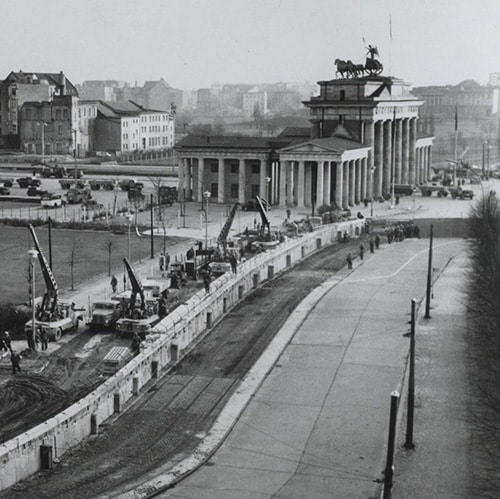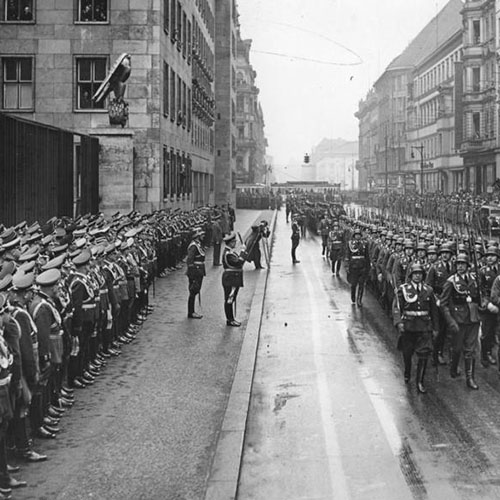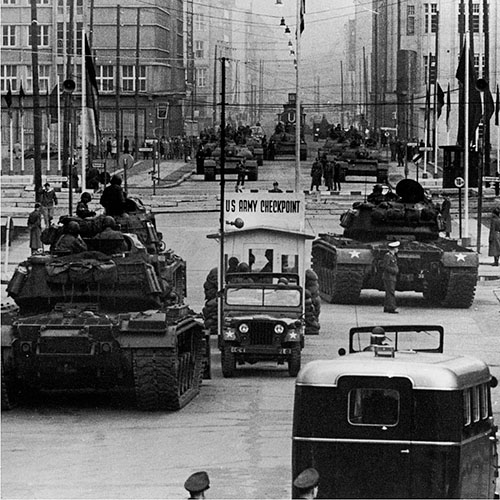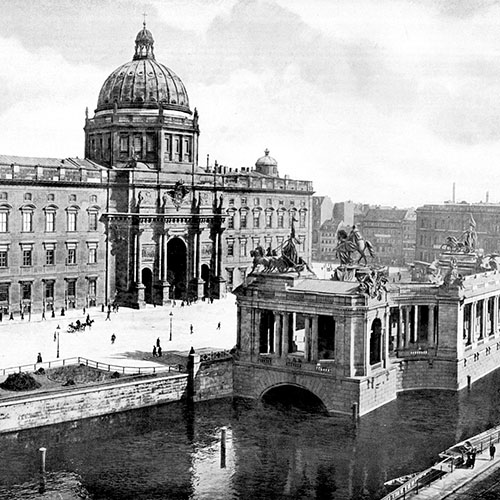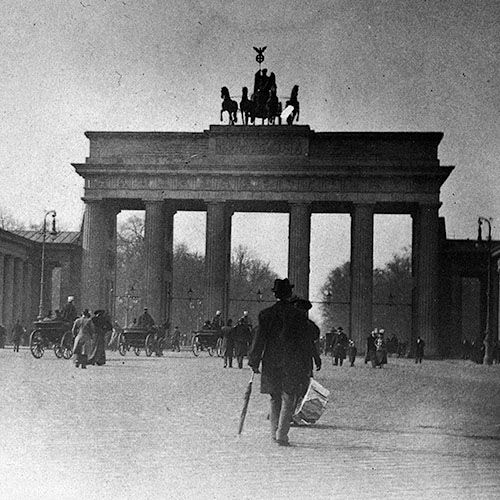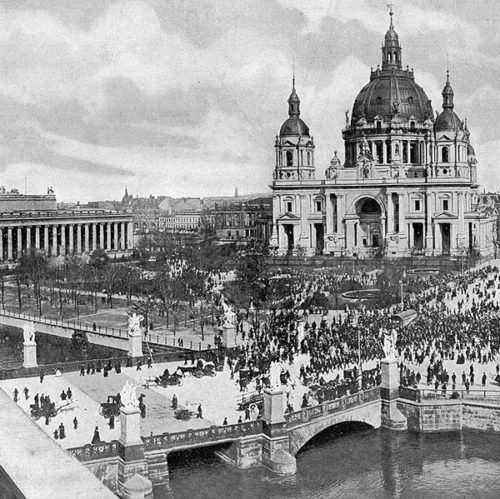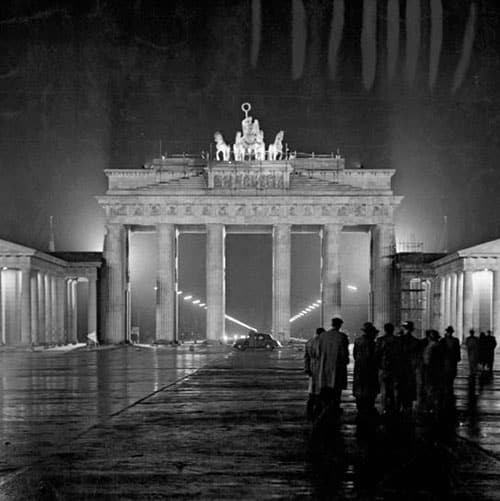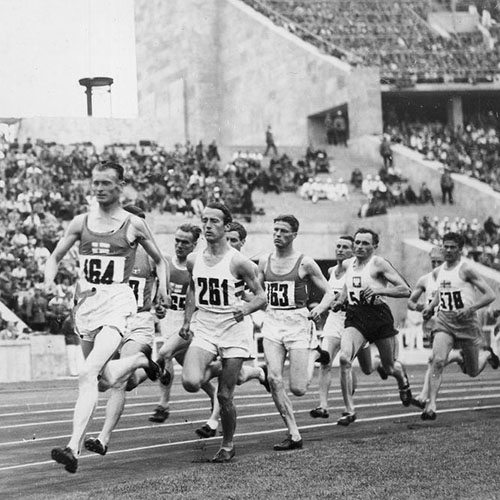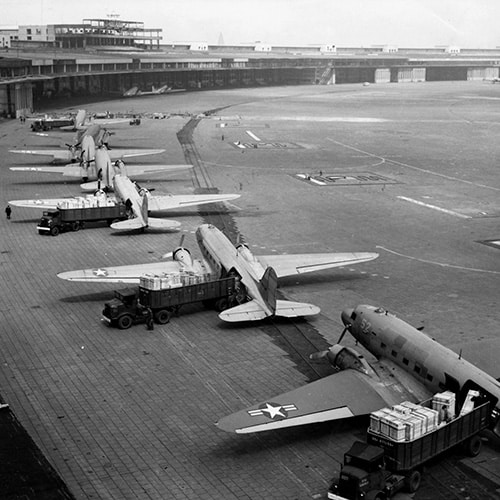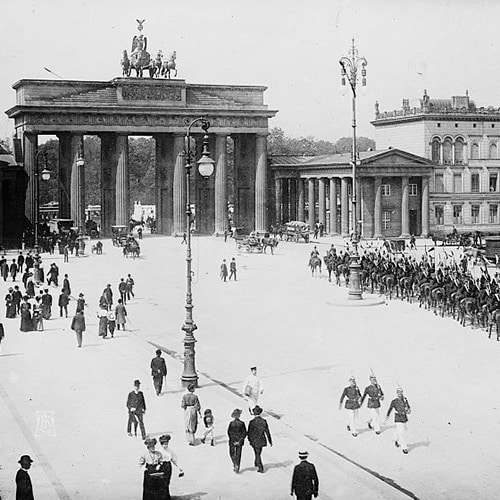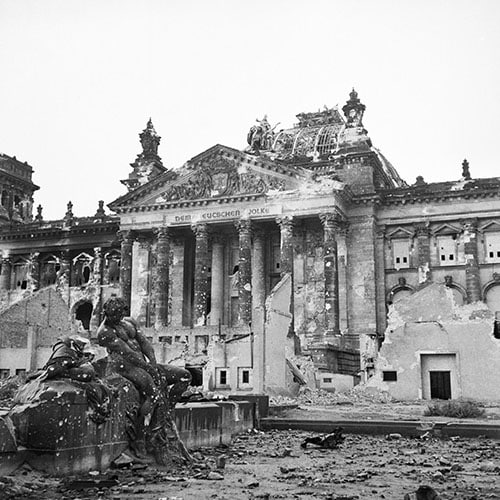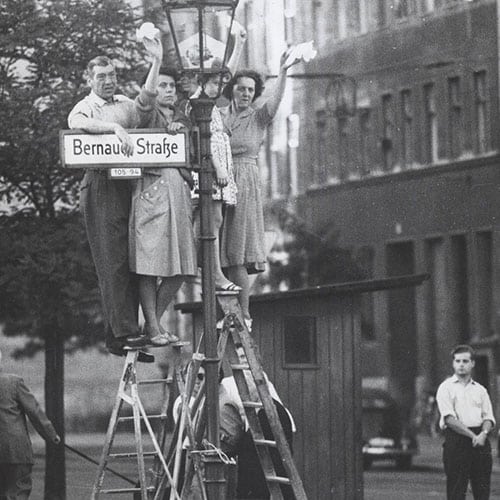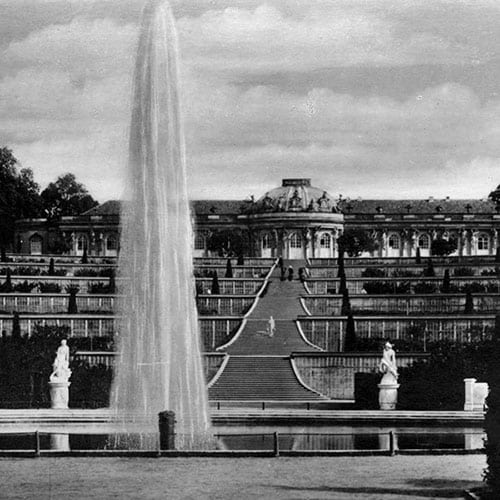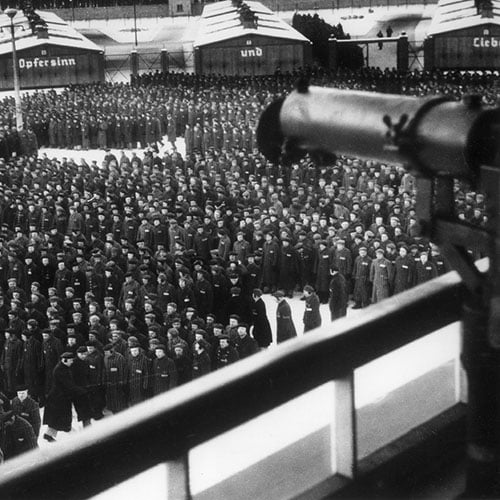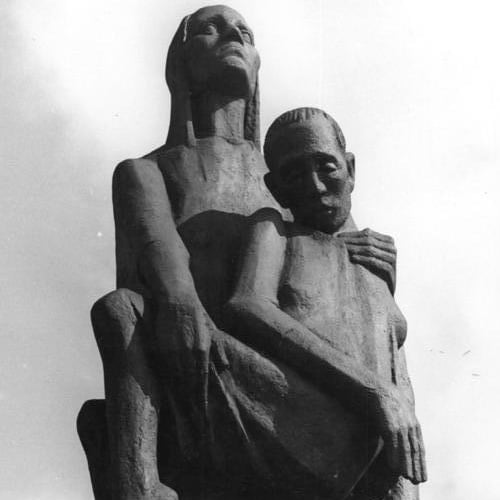“The most dangerous moment comes with victory.”
Napoleon Bonaparte
On a bloodstained rooftop in Berlin in May 1945, a young Soviet photographer clicked the shutter of his Leica camera. Through his viewfinder, the outline of a Red Army soldier raising the Soviet flag amidst the ruins of the conquered Nazi capital was visible.
That location of this photograph had stood empty for twelve years—since the suspicious fire here in 1933 that had propelled the Nazi Party into power—was of little consequence to this group of assembled men. For these soldiers, and the more than two million others now converging upon the city, the significance lay not in its recent past, but largely in its name.
A name that carried the weight of history, power, and a distinctly Germanic, guttural resonance: the Reichstag.
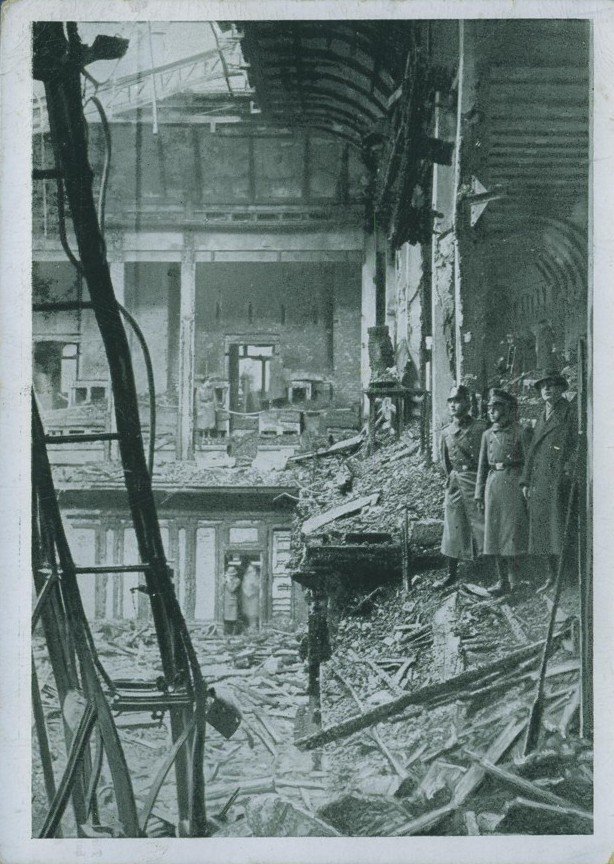
Officially designated Red Army Target No. 105, the Reichstag would serve as a rallying cry for Soviet troops across Europe and Asia, the act of taking the building representing the moment of complete submission of the German – and Nazi – war machine.
This immortalised moment would eventually become among the most iconic photographs of the Second World War—celebrated for its symbolism yet shrouded in controversy.
Ukrainian photographer, Yevgeny Khaldei, had assembled three soldiers on the roof of the Reichstag in the early hours of May 2nd, as the surrender of the city had not yet been announced. On closer inspection of the photograph, the silhouette of the Brandenburg Gate is barely visible in the background through a veil of smoke with the Soviet hammer & sickle flag recognisable in the foreground, held by a soldier who is precariously perched on the edge of the parliament building. Beneath him can be seen the two other soldiers.
The flag, caught in the wind, is clearly pointing eastwards. Towards Moscow.
Victory, it is said, deserves a spectacle – and also requires adequate framing.
This iconic shot was first published on May 13th 1945 – almost two weeks after the event – in Ogoniok, one of the oldest weekly illustrated magazines in Russia.
Khaldei had been directly inspired by a photograph that had appeared in publications in the United States some three months earlier. That of six United States Marines raising the stars & stripes atop Mount Suribachi during the closing stages of the Battle of Iwo Jima. An image taken by Joe Rosenthal of the Associated Press, for which Rosenthal would go on to win the 1945 Pulitzer Prize for Photography.
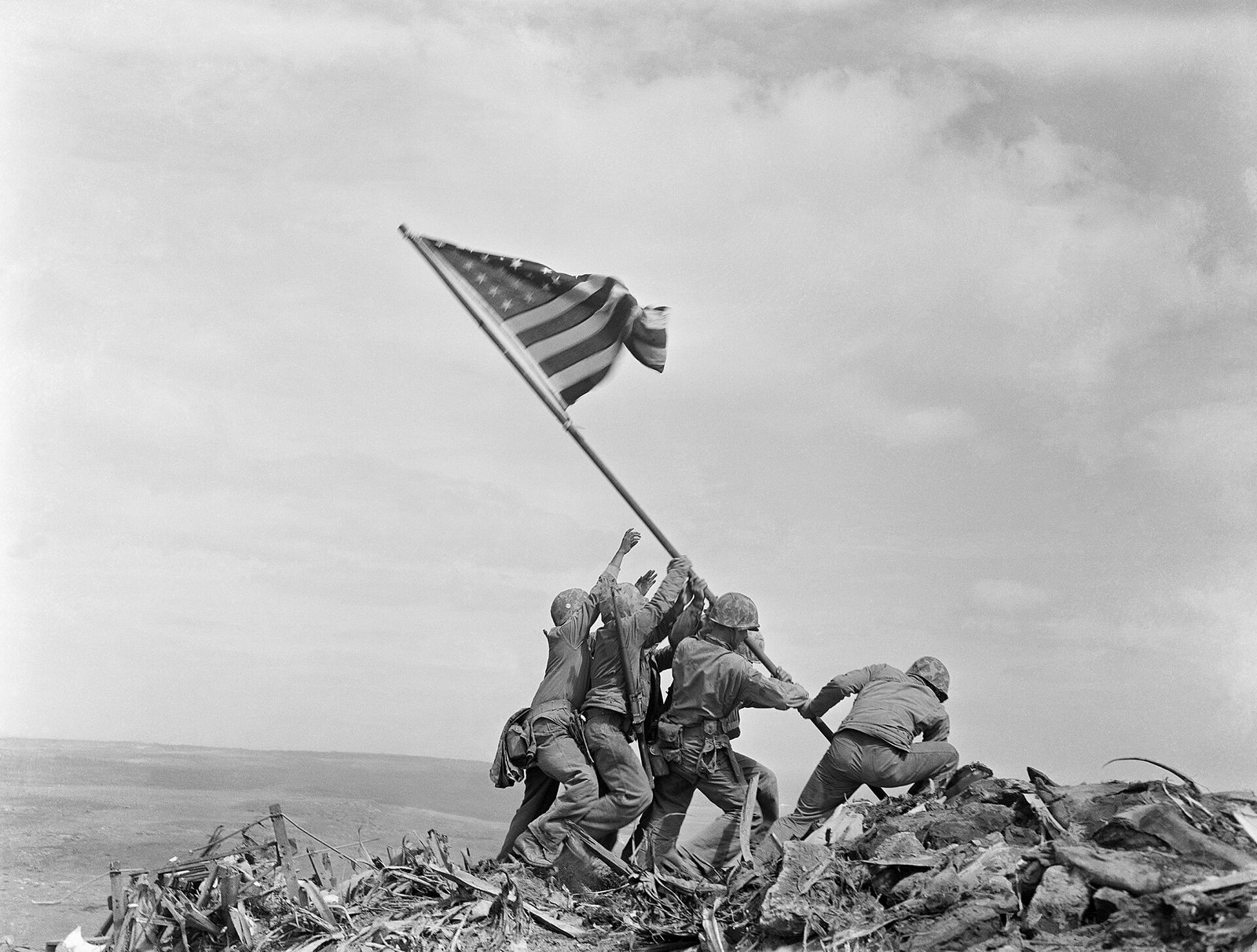
Not unlike the later photograph taken by Khaldei in Berlin, this moment of celebration was captured at a time when fierce fighting was still taking place. Three of the six men in that immortal image would not survive to see the liberation of the island of Iwo Jima from Japanese forces.
As it happens, the authenticity of both photographs would also be brought into question by critics.
On the morning of February 23rd 1945, a US patrol had reached the top of Mount Suribachi and managed to raise the first US flag on the vital vantage point. Ultimately considered too small (at 137 cm × 71 cm), it was replaced with a much larger flag (243cm x 142cm) by different participants later in the day. It was that second flag raising on Iwo Jima that Rosenthal witnessed, and managed to snap, immediately sending his photo back to the island of Guam for processing, from where it would be put out on the Associated Press wire and syndicated at newspapers across the United States. An impressive turnaround of only seventeen and a half hours after the shot was taken.

The first flag raising on Iwo Jima was also documented, by Staff Sergeant Louis R. Lowery of Leatherneck magazine (the official publication of the US Marine Corp), and while as emotive as Rosenthal’s later photograph, its delayed release and the aesthetic considerations of later editors meant that this image – and the event it depicted – would be neglected at best, at worst denied.
The exact identities of the participants in both Iwo Jima photographs would also remain unclear for decades to come. Despite the presence of an additional cameraman recording motion picture evidence of the second flag raising at the same time as Rosenthal’s photograph was taken, allegations that the event was entirely staged for effect persist.
Much the same can be said for the Reichstag flag raising. Was it the first to take place on the building or merely a carefully staged reconstruction? And who are the men featured in the image? Why there and why then?
The idea that an image can encapsulate the essence of a thousand words speaks to the profound language of the visual.
In the case of these photographs, many of those words are still followed with question marks.
–
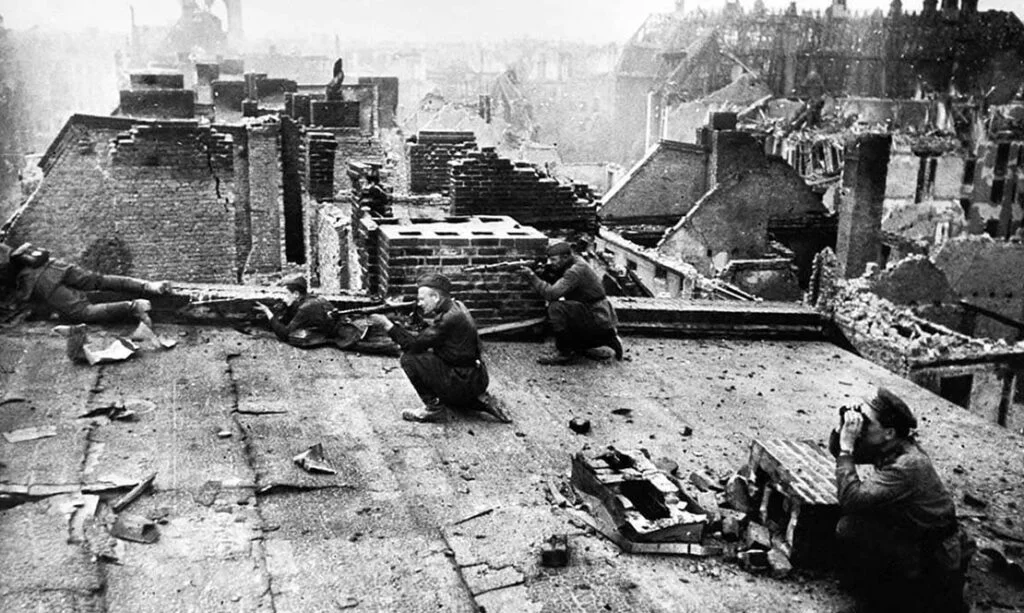
The Battle Of Berlin
“We no longer fought for Hitler, or for National Socialism, or for the Third Reich,’ wrote an Alsatian veteran of the Grossdeutschland Division, ‘or even for our fiancées or mothers or families trapped in bomb-ravaged towns. We fought from simple fear… We fought like rats.”
Antony Beevor
Twelve years after the Nazi seizure of power, the fight for the future of Europe rumbled chaotically onto the streets of the German capital.
In the afternoon of April 21st 1945, one day after Adolf Hitler’s 56th birthday, elements of the Soviet 5th Shock Army had managed to reach the eastern Berlin district of Marzahn. Earlier that morning, Soviet artillery had begun bombarding central Berlin, waking the alarmed Nazi leader in his underground lair at around 9:30 am.
The Battle for Berlin was now very much underway.
Three Soviet Fronts (the 1st Belorussian, 1st Ukrainian, and 2nd Belorussian) were poised to attack Berlin by January 1945. These 2.5 million men had swept across the north of nowadays Poland, through Eastern and Western Prussia, until they arrived at the banks of the Oder river. From points some 115 km east from the Nazi they would begin their final assault on the heart of Nazi Germany on April 16th 1945 – finally accepting the unconditional surrender of the German land, sea, and air forces on May 8th.

Soviet urban warfare tactics — honed in battles like Stalingrad — proved brutally effective in Berlin. Small storm groups led the way: infantry with submachine guns, grenades, and satchel charges, often supported by tanks and self-propelled guns. These assault teams would infiltrate as close as possible, then charge into buildings under covering fire. They cleared one structure after another by blasting holes through walls and hurling grenades to flush out defenders. Flamethrowers and demolition charges were used to burn or blow apart German nests in cellars and upper floors.
The Soviets even improvised defenses on their tanks – wiring bed springs and mattresses onto hulls – to lessen the danger of Panzerfaust anti-tank rockets. Each captured block or intersection was immediately secured to prevent German counterattacks from cutting off the advancing units. Progress was block-by-block, with every ruined apartment or factory turned into a mini-fortress to be reduced. The fighting was “house-to-house and room-to-room,” and casualties mounted on both sides in these bitter close fights. German defensive tactics in the city made the Soviets pay for every meter.
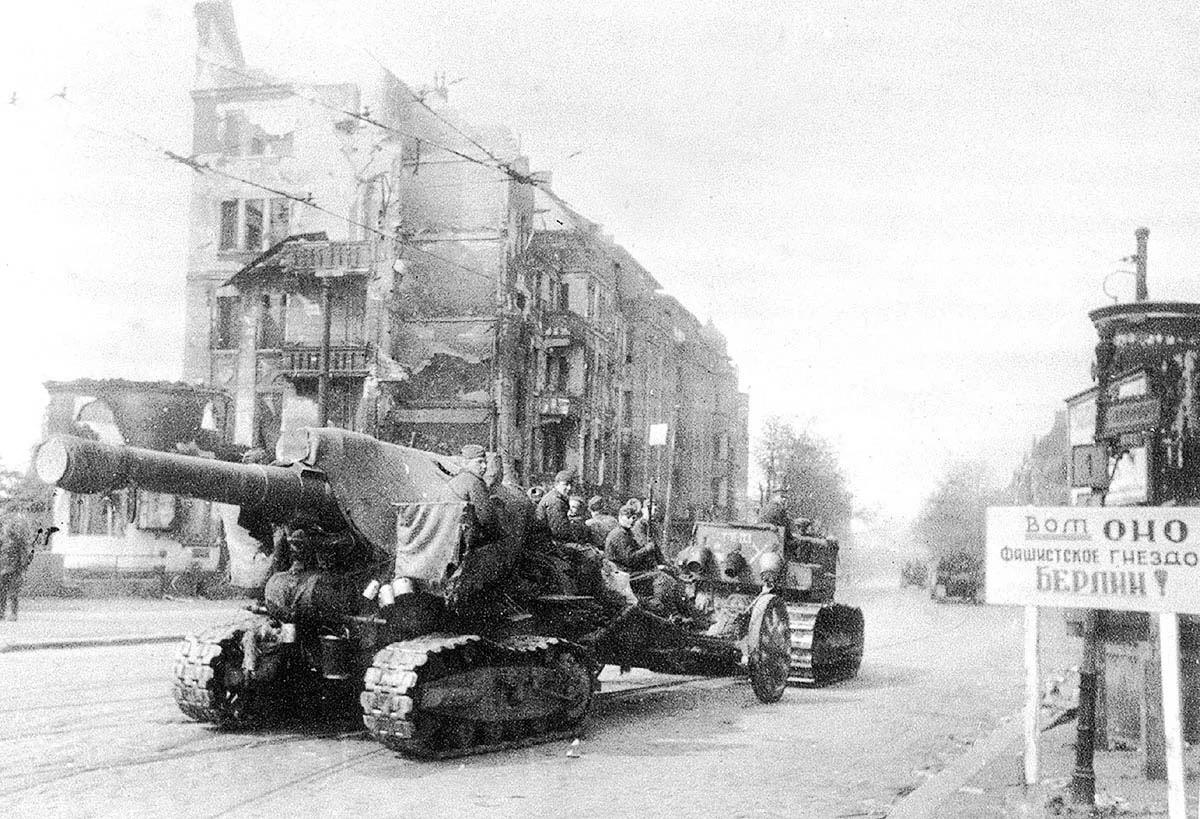
Instead of meeting the Red Army in the open streets, the defenders took positions in upper floors, attics, and behind piles of rubble. Snipers concealed in shattered buildings preyed on exposed Soviet soldiers, slowing the assault with lethal long-range fire. Makeshift barricades of masonry, overturned tramcars, and sandbags crisscrossed major avenues, often covered by machine guns and anti-tank teams.
At key junctions, German crews had dug in 20mm and 37mm flak guns to fire directly at Soviet infantry.
Hidden Panzerfaust teams lurked in cellars and alleyways, ambushing any Soviet tank that pressed too far ahead. The city itself became a weapon: sewers channeled sudden flank attacks, while broken sewer mains and water from firefighting had flooded some underpasses into impassable moats. With infrastructure in ruins, Soviet tanks and trucks found streets blocked by bomb craters and wreckage. Rubble had to be cleared or bulldozed aside under fire.
Yet the Red Army adapted — engineer squads worked under fire to breach barricades and disarm mines, and Soviet submachine gunners climbed through blasted buildings to outflank German positions from the sides or rear.
The relentless pressure left Berlin looking “apocalyptic and infernal…fire and destruction” everywhere. Whole districts were reduced to charred ruins as Soviet artillery and rocket batteries blasted any suspected strongpoint before infantry moved in.
Amid this destruction, terrified civilians cowered in basements while street by street, with each new percussive assault, the Soviets inched closer towards their chief objective – the ruined German parliament.
To the enemies of Nazi Germany, it had all the attributes deserving of the lair of the fascist beast, yet to the Nazis themselves it was a representation of the weaknesses of democracy and representative government.
Something which in 1933, they had first shunned, then subverted, and eventually destroyed.
–
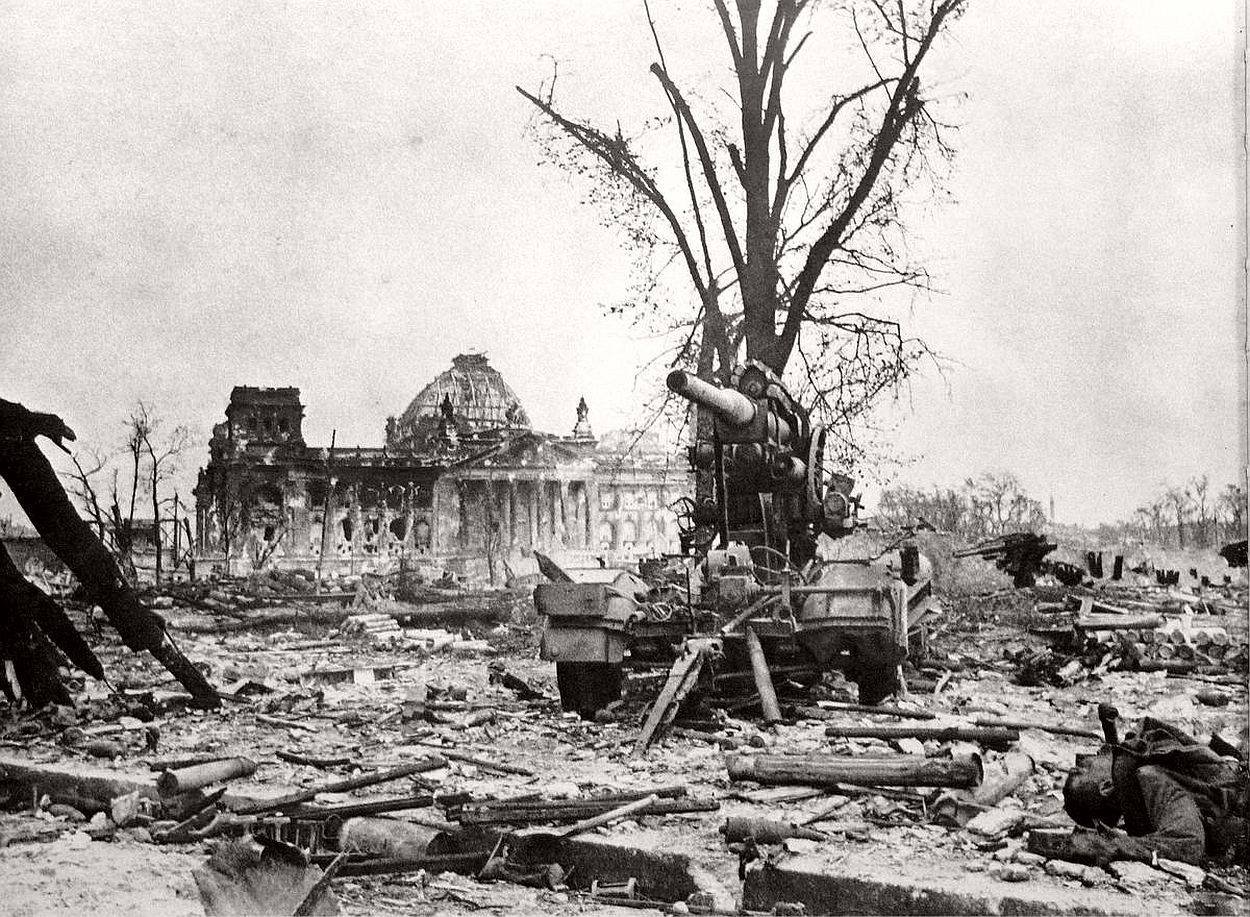
The Fight For The Reichstag
“We are entering the government in order to stay in it. Either we rule Germany, or we fall with Germany. There is no other possibility.”
Joseph Goebbels, Nazi Propaganda Minister & Gauleiter of Berlin
The men of the 150th Rifle Division — part of the Soviet 3rd Shock Army’s 79th Rifle Corps — spearheaded the push from the north and northwest towards the Reichstag.
They fought block by block through the city’s outer districts, overcoming desperate German resistance. Berlin’s defense, a mix of Wehrmacht remnants, SS troops, Hitler Youth, and Volkssturm militia, was outnumbered but fought tenaciously in the ruined streets.
As Soviet columns pressed inward, German General Helmuth Weidling’s 45,000 defenders turned the city into a maze of strongpoints despite dwindling supplies.
The Red Army’s advance was methodical and unrelenting, encircling the city by April 25th and squeezing the defenders into the central boroughs. Each day brought Soviet assault troops closer to Hitler’s bunker, heightening the sense of doom among Berlin’s inhabitants.
On the night of April 28th 1945, Soviet forces set their sights on the Moltke Bridge, the last heavily fortified crossing over the Spree before the Reichstag. The Germans had turned the elegant stone bridge into a veritable fortress. When Soviet advance units approached, they found the bridge’s span damaged but intact – German engineers had detonated charges, buckling the structure without bringing it down.
At both ends of Moltkebrücke, the defenders had erected one-meter-thick concrete barricades and piled debris to block passage. Machine-gun nests and anti-tank guns were zeroed in on the bridge’s approaches, creating a deadly crossfire zone.

German artillery from the Tiergarten and the Zoo Flak Tower also ranged in on the span, ready to smash any crossing attempt. Under these conditions, a frontal rush was suicidal – all avenues onto the bridge were swept by multilayered fire. Soviet commanders decided to halt and prepare a concentrated assault for the next day. Through the late hours of April 28th, Red Army guns pounded the German strongpoints guarding the bridge.
Heavy 152mm howitzers and field guns methodically destroyed the entrenched positions on the north and south embankments (the Kronprinzenufer and Schlieffenufer) that covered the bridge. This suppressive bombardment through the night silenced many enemy batteries and cleared the way for a crossing attempt.
In the pre-dawn darkness of April 29th, specially tasked Soviet combat engineers crept onto the damaged Moltkebrücke. Amid intermittent firefights, these sappers worked to disable any remaining German demolition charges and to assess the bridge’s stability.
They gingerly reinforced sections of the buckled roadway with timber and steel beams so that infantry and light vehicles could cross.
At 1am, under cover of smoke and artillery bursts, assault teams from the 150th Rifle Division (Captain S. Neustroev’s battalion) and the 171st Rifle Division (Lt. K. Samsonov’s battalion) dashed onto the bridge. The first wave took horrific casualties – German machine gunners, only a couple hundred yards away, riddled the span with bullets, and a cacophony of explosions erupted as mortars and grenades rained in.
But some Soviet troops made it across the fractured southern end of the bridge, leaping over gaps where the pavement had fallen into the Spree. These men established a fragile bridgehead on the far bank, immediately engaging German troops in close combat among the sandbag walls.
By dawn, forward elements of the 79th Rifle Corps had secured the south side of Moltkebrücke, though the fight raged at close quarters in the surrounding streets.
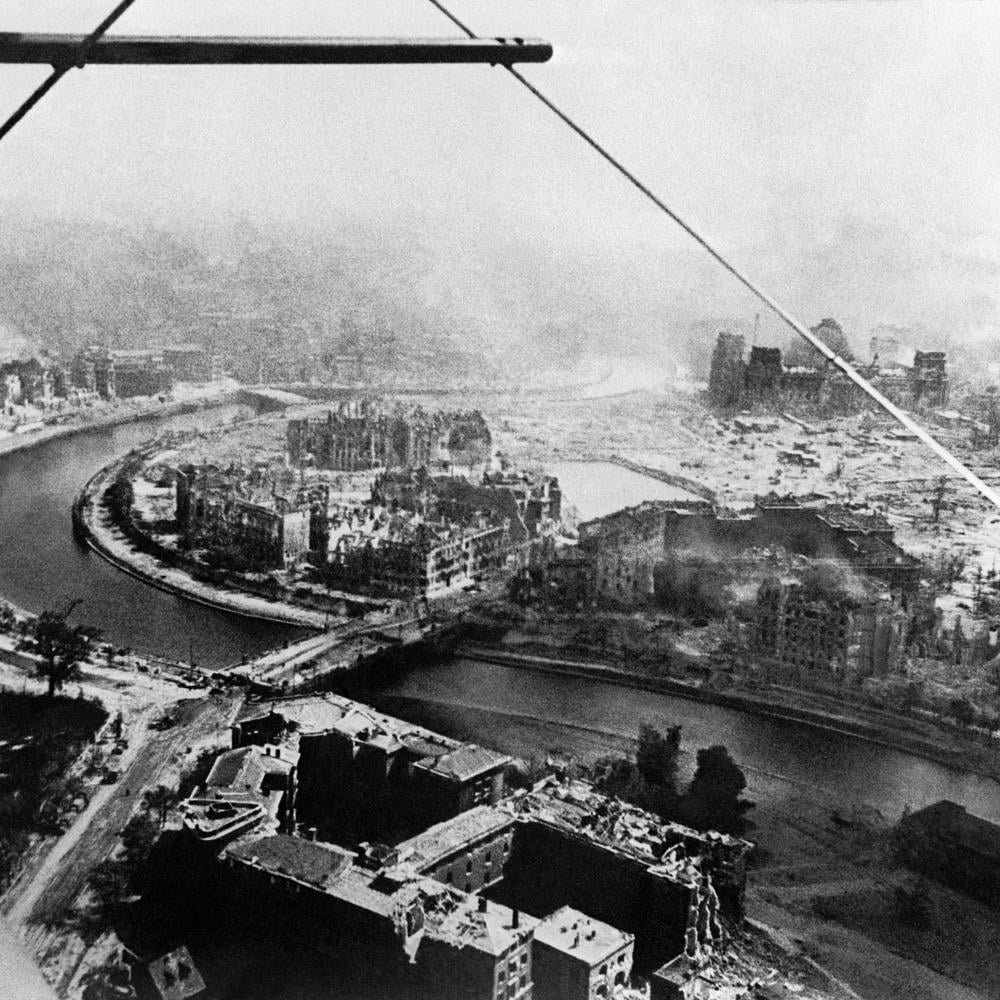
Key factors decided the outcome of the Moltke Brücke battle:
- Massed Fire Support: The Soviets brought in tanks and self-propelled guns onto the northern bank to fire point-blank across the river. Once the bridgehead was formed, these AFVs rolled forward, adding their 85 mm and 122 mm shells to suppress remaining German bunkers. Meanwhile, batteries on the north bank continued to lob shells over the heads of the Soviet infantry, keeping German counterattacks at bay. This coordination of direct and indirect fire gradually overwhelmed the bridge’s defenders.
- Engineer Bravery: Soviet sappers were instrumental. They disarmed explosives under fire and laid wooden planks across the twisted girders, enabling more troops and even a few light tanks to get across before the bridge could be demolished. Their swift work kept the momentum of the assault and prevented the Germans from destroying the crossing completely. One account recalls engineers hacking away at cables attached to unexploded charges while bullets snapped around them, quite literally saving the bridge for the advancing Red Army.
- German Tenacity: The German troops, including SS from the Nordland Division and Volkssturm militia, fought hard for every inch. They had prepared overlapping fields of fire and had pre-sighted artillery targets on the bridge. Even after Soviet troops gained the far bank, the Germans mounted furious counterattacks in the adjacent Ministry of the Interior and diplomatic quarter buildings, trying to push the attackers back into the river. Each counterattack was met with withering Soviet fire and often point-blank tank blasts, resulting in grisly losses among the last German defenders.
By midday on April 29th, the Moltke Bridge was firmly in Soviet hands, at the cost of significant casualties.
The struggle for this single bridge had been a “haemorrhaging of casualties” for the Soviet side, as the open crossing made infantry easy targets.
Likewise, German losses were heavy; many lie dead on the approaches, cut down by Soviet fire or crushed under falling masonry when their strongpoints were blown apart. Securing Moltke Brücke proved decisive: it gave the Red Army a crucial bridgehead for the final attack on the Reichstag, allowing tanks of the 23rd Tank Brigade and assault guns of the 88th Guards Heavy Tank Regiment to roll into central Berlin.
As Soviet armor clattered across the battle-damaged bridge and fanned out into the Tiergarten, the last chapter of the Battle of Berlin was about to unfold. The Reichstag, scarred by war and symbolic of Hitler’s regime, loomed just a few hundred meters away.
Soviet troops regrouped and prepared for a concentrated frontal assault on that massive building on April 30.
At 1pm, on April 30th 1945, the Red Army unleashed a ferocious artillery barrage on the Reichstag – the final prelude to storming Hitler’s symbolic seat of power. A total of 89 guns — including 152 mm and 203 mm heavy howitzers, tank guns, self-propelled assault guns, and Katyusha rocket launchers — opened up simultaneously, all aimed directly at the Reichstag’s hulking silhouette. For a full half hour, the iconic building was pounded without mercy. Shells crashed into its stone walls, rockets whistled in and exploded on the roof, and even captured German Panzerfausts were fired by Soviet infantry into the lower windows. Smoke and debris filled the air, turning midday into near-darkness amid the thunder of explosions. Observers recalled that the bright spring day turned to gloom from the volume of dust and smoke kicked up by the barrage.
This overwhelming artillery preparation was intended to soften up the German defenses and stun the garrison before the infantry assault. Inside the Reichstag, the German defenders – a mix of Waffen-SS, stragglers from various Army units, and Navy auxiliaries – hunkered down as the massive building shook to its foundations. Many of them had pledged to fight to the death.
While the bombardment tore gaping holes in the façade and ignited fires, it did not completely eliminate the defenders. After months of air raids and street fighting, the Reichstag’s interior was already a wreck of collapsed floors and rubble piles, which actually provided the Germans with ready-made cover and barricades.
Once the 89-gun barrage lifted, Soviet assault teams rushed to exploit whatever shock it had inflicted.
–
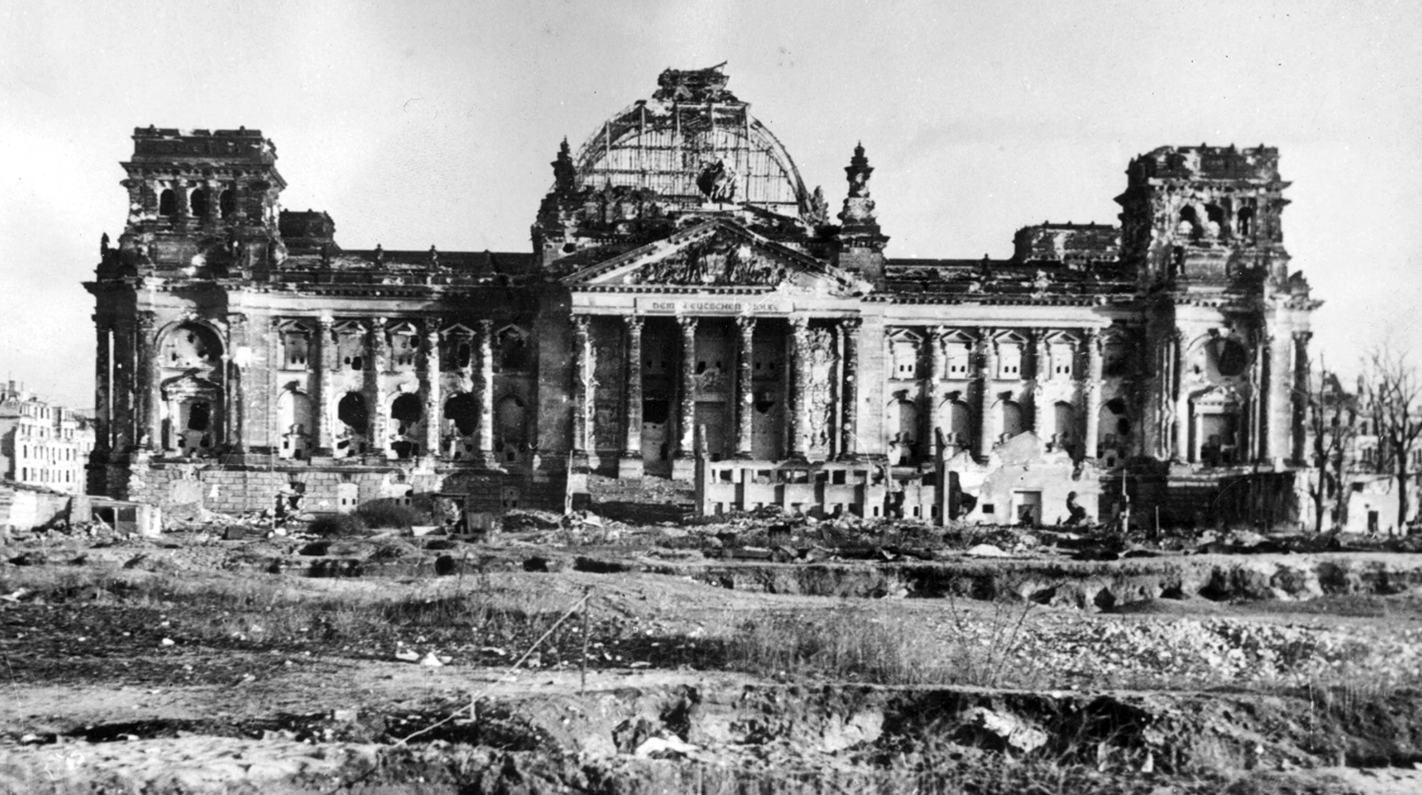
The Final Stage Of The Reichstag Battle
“The problem after a war is the victor. He thinks he has just proved that war and violence pay.”
A. J. Muste
The Soviet command was nothing short of obsessed with capturing the Reichstag by May 1st in order to be able to mark the victory over fascism on International Workers Day.
It would take a series of final desperate and suicidal pushes from Soviet troops to conquer the building in time.
The idea of a victory banner was expressed by Joseph Stalin in the fall of 1944 at a ceremonial meeting of the Moscow City Council dedicated to the 27th anniversary of the October Revolution.
“Now,” said the Supreme Commander-in-Chief, “the Red Army has its last, final mission: to complete, together with the armies of our allies, the task of defeating the Nazi army, to finish off the fascist beast in its own lair and to raise the Victory Banner over Berlin.”
The men responsible for raising this banner would be promised the highest recognition available for their actions – the Hero of the Soviet Union.
Under cover of lingering smoke, Captain Stepan Neustroev’s 1st Battalion of the 756th Rifle Regiment (150th Division) led the charge toward the Reichstag.
From the captured Interior Ministry next door, Soviet infantry poured out of ground-floor windows and sprinted across the open Königsplatz square in front of the Reichstag. They faced approximately 300 meters of open ground, littered with shell craters and a flooded anti-tank ditch that ran north–south across the lawn. German machine guns and rifles opened up immediately from the Reichstag’s firing ports.
Despite the bombardment, the building’s defenders had regrouped and now poured a deadly hail of bullets into the advancing Soviets. Dozens of men fell mid-stride on the Königsplatz, cut down by interlocking fields of MG-42 fire.
The German defensive measures were formidable: in anticipation of this very assault, they had bricked up almost all ground-floor windows and doors with masonry, leaving only small loopholes for their machine gunners to fire through. The wide stone stairs at the main entrance were blocked with sandbags behind which riflemen crouched.

Just in front of the Reichstag, the Germans had emplaced four 105mm field guns and an 88mm flak cannon in direct-fire mode, positioned to sweep the square at point-blank range. As Soviet infantry tried to rush forward or skirt the flooded trench, these guns blasted them with high-explosive shells and deadly flak bursts.
In addition, from the southwest the defenders enjoyed support from the Zoo Flak Tower roughly 2km away – atop that concrete bastion a 128mm dual-purpose gun zeroed in on the Königsplatz and began lobbing heavy shells at any concentrations of Soviet troops. Under this withering fire, the first Soviet assault wave recoiled.
Between 4am and 6am that morning, several earlier attempts by the 150th and 171st Divisions to seize the Reichstag “on the move” had already been beaten back. Now the midday frontal attack was also taking punishing losses, and many Soviet soldiers hugged the ground, pinned by intense fire from the Reichstag and the adjacent Kroll Opera House (another strongpoint to the north). It was clear that the Reichstag, even shattered and burning, was still a tough nut to crack.
Nevertheless, the Red Army kept up the pressure.
Soviet tanks and self-propelled guns were brought forward onto the Königsplatz to support the infantry. IS-2 heavy tanks and SU-76 assault guns rolled past craters and began hammering the Reichstag at point-blank range, firing high-explosive shells directly into the bricked-up openings. Each blast blew apart sections of masonry, widening breaches in the walls. Under this cover, small groups of Soviet sappers rushed forward with Bangalore torpedoes and satchel charges to clear the barbed wire and debris at the base of the building.
Around 2:30pm, enough of a foothold was gained at the ground floor that assault groups could push inside. Intense close-quarters combat erupted as Soviet troops entered the Reichstag’s lower level. The interior was dark, dusty, and littered with wreckage. German defenders had set up machine guns in the corridors and behind makeshift barricades of overturned tables, sandbags, and even marble statues. What followed was a brutal room-to-room struggle. Grenades and bayonets became the weapons of choice in the labyrinth of half-collapsed hallways.
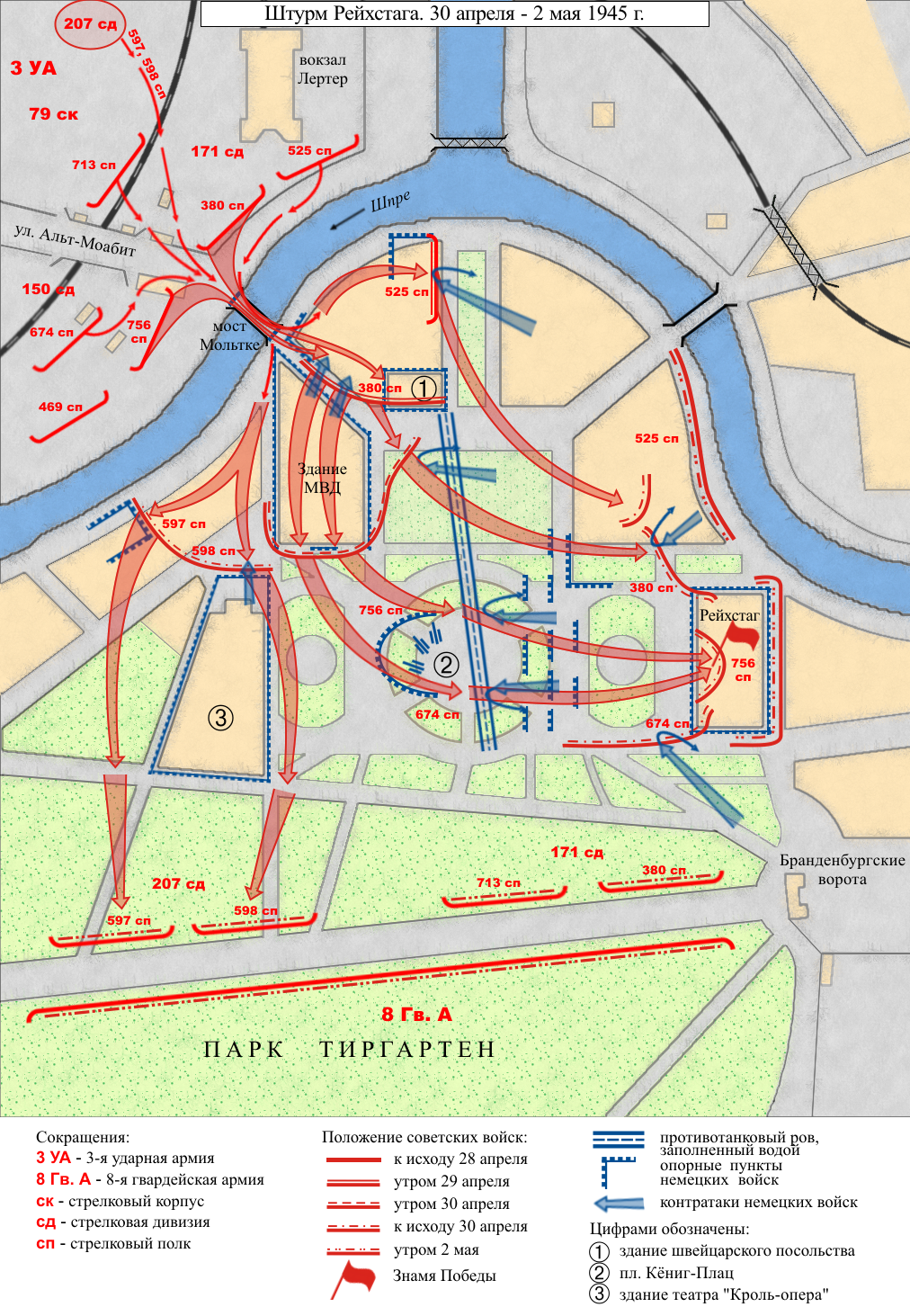
Soviet soldiers tossed grenades into rooms before clearing them, while Germans retaliated with Panzerfaust blasts down corridors. At times, the fighting was hand-to-hand – bayonet thrusts, rifle butts, and even knives in a desperate melee. “The battle raged on every floor,” one Soviet officer recalled, with firefights erupting in stairwells and sniper fire coming from upper gallery positions. Soviet combat engineers methodically blew open heavy doors with explosive charges or small mortars to force their way into barricaded chambers. As each level was secured, Soviet troops raised small red banners or even strips of red cloth as signals to those outside that “this floor is ours”.
By late afternoon, the 150th Division had cleared the first and second floors of the Reichstag’s north and west wings.
–
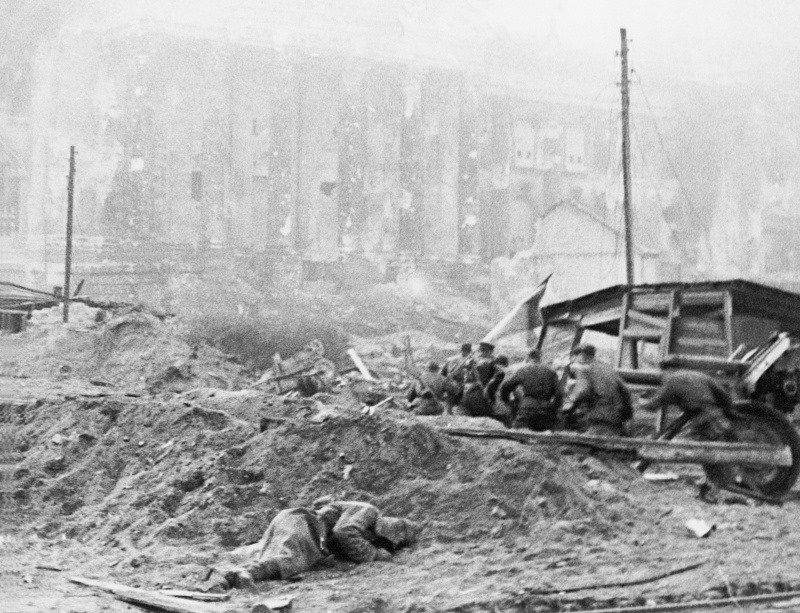
The Flag Raisings
“… each of the armies advancing on Berlin prepared one red banner to be raised over the Reichstag building. On April 22, 1945, the 3rd Shock Army prepared 9 such banners (according to the number of divisions included in it). Red banners, flags and pennants were in all the assault groups that went into battle with the main task of breaking into the Reichstag and raising them on the building. In total, about 40 flags were raised over the Reichstag.”
The Institute of Military History of the Ministry of Defense of the Russian Federation
The beleaguered German garrison trapped in the Reichstag refused to surrender.
They fell back to the upper stories and the vast cellar, turning each into a last redoubt. Soviet progress slowed as pockets of defenders launched counterattacks in the dimly lit interiors.
It took hours of bitter combat, but the Soviets steadily gained ground.
By the evening of April 30th, after roughly 12–14 hours of fighting, the Red Army had taken most of the Reichstag except for isolated holdouts.
At about 10:40pm that night: two Soviet soldiers, Meliton Kantaria and Mikhail Egorov of the 756th Regiment, along with a handful of comrades, managed to reach the Reichstag’s rooftop after finding an unguarded stairwell.
Under fire, they climbed out near the ornate stone pediment and hoisted a red flag (the Victory Banner of the 150th Rifle Division) high above the building.
They jammed its staff into a statue on the roof – the bronze figure of Germania – and the red flag unfurled in the night wind. This was the iconic moment symbolizing the Soviet victory, though it happened in darkness with flares and tracers still streaking across the sky. Below them, fighting still raged in the Reichstag’s lower levels.
Or at least, so the official version of events goes.
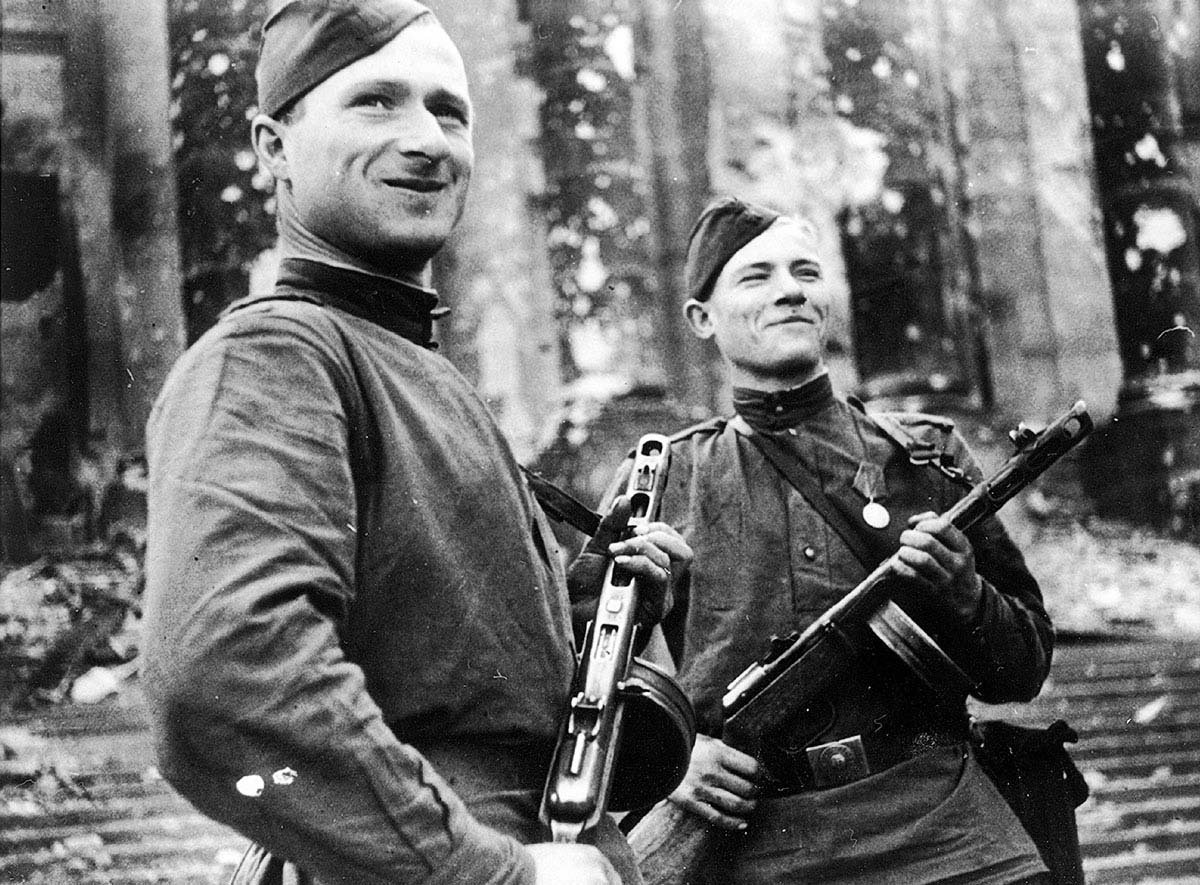
This was, however, not the only flag raising that took place on the building; many other Soviet troops had fought to do the same. Some were successful. Many died in the charge.
The three major Soviet assaults on the building on April 30th had been beaten back by the German defenders successfully – at 4:30am, 11:30am, and 1pm – with heavy losses sustained by the Red Army.
Despite the lack of progress, the chief of staff of the 150th Rifle Division, Colonel Nikolay Dyachkov stated in an official correspondence sent to his superiors: “I report that at 14:25 on April 30th, 1945, having broken the enemy’s resistance in the blocks northwest of the Reichstag building, the 1st battalion of the 756th Rifle Regiment and the 1st battalion of the 674th Rifle Regiment stormed the Reichstag building and raised the Red Banner on its southern part… ”
This false report had been sent directly to Moscow and led to war correspondents converging on the Reichstag, to find that the infantry had by this time only managed to advance halfway across the Königsplatz square in front of the building.
In response, Major General Sayanov, Commander of the 150th Rifle Division, ordered his men to raise a flag on the building, whatever the cost.
Pressure from above to take the Reichstag before the May 1st deadline – now increased by Dyachkov’s erroneous message – led to a dozen temporary successes and many more false reports:
- Two attempts to airdrop six-meter red banners with the words “VICTORY” on top of the Reichstag using planes were made. The fabric that did catch on the bombed out dome of the building, however, was swiftly blown away by the wind.
- A 19-year-old Red Army private, Grigory Petrovich Bulatov, reportedly raised the first red flag on the Reichstag, made out of a pillowcase. Kazakh Lieutenant, Rakhimzhan Qoshqarbaev, commander of a reconnaissance platoon which belonged to the 674th Infantry Regiment, is attested as having joined Bulatov as the flag was raised inside the Reichstag by 2:30pm, in the entrance by the staircase. Later he would ensure this was moved to the rooftop on the night of April 30th. The flag it is said was later shot down by German snipers. All participants in this attempt were nominated for the title Hero of the Soviet Union, but were instead awarded the Order of the Red Banner
- Two separate groups, led by M. M. Bondar from the 380th Rifle Regiment and Captain V. N. Makov of the 756th Rifle Regiment, both claimed to have raised flags over the Reichstag on April 30th before Kantaria and Yegorov managed to secure their Victory Banner.
- A group of soldiers of the 136th Artillery Brigade led by Mikhail Minin, together with senior sergeants Zagitov and Lisimenko, and sergeant Bobrov, claimed to have slipped into the Reichstag unnoticed by the defenders on April 30th. They found a locked door and knocked it down with a log, climbing to the attic and making their way to the roof through a broken window. They managed to place a banner in the opening of the crown of the sculpture of the Goddess of Victory. The group remained on the rooftop until 5am guarding the flag until they were relieved. Each participant would be nominated for the highest government award – the title of Hero of the Soviet Union – but later only receive the Order of the Red Banner.
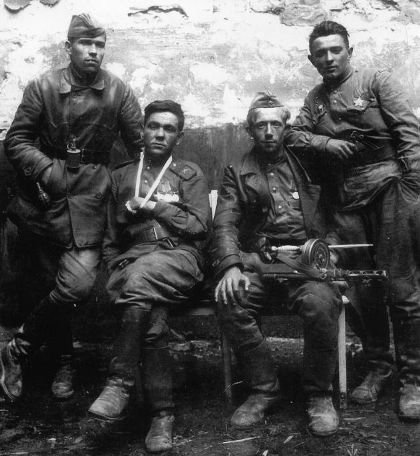
It wasn’t until May 2, 1945 – two days later – that the last die-hard German defenders in the basement finally capitulated. Cut off and with no hope of relief, approximately 2,500 German soldiers emerged from the damp cellars and surrendered that morning.
The Soviet troops, exhausted but triumphant, at last declared the Reichstag secure.
The official statement from the heads – Colonel General Kuznetsov and Major General Litvinov – of the Soviet 3rd Shock Army, responsible for the capture of the Reichstag, would state the following:
“The commander of the 1st Belorussian Front, Marshal of the Soviet Union Comrade Zhukov, ordered the troops of the 3rd Shock Army to rapidly advance forward, break into Berlin, seize the central district of the city and the Reichstag, and raise the Victory Banner on it.
Having defeated the enemy on the immediate approaches to the city, the army troops were the first to break into Berlin at 6:00 on April 21st, 1945. Units of the 79th Rifle Corps of Major General Perevertkin, developing the offensive, approached the city center with stubborn street fighting.
Having captured the central part of the city, Moabit, the troops of the 3rd Shock Army penetrated into the Reichstag area by the end of April 29th 1945.
On April 30th, at dawn, the general assault on the Reichstag began. The banner was handed over to Colonel Zinchenko’s 756th Rifle Regiment , which was advancing on the Reichstag in the first echelon of the 150th Rifle Division, and in the regiment to the company of Senior Sergeant Syanov from Captain Neustroev’s battalion.
On April 30th 1945, at 14:25, the soldiers of Senior Sergeant Syanov’s company fought their way up the stairs to the roof of the building and reached the dome of the Reichstag. The brave soldiers, Communist Lieutenant Berest, Komsomol member Red Army soldier Yegorov and non-party junior sergeant Kantaria, installed the banner, and the proud flag of the Soviet Union, a symbol of our great victory, was raised over the building of the German parliament.
This historical moment of raising the Victory Banner over Berlin was marked on April 30th, 1945 by order No. 06 of the commander of the 1st Belorussian Front, Marshal of the Soviet Union Comrade Zhukov.
The banner raised above the Reichstag, pierced by bullets and scorched, fluttered triumphantly over defeated Berlin.
Commander of the 3rd Shock Army, Hero of the Soviet Union, Colonel General Kuznetsov
Member of the Military Council of the 3rd Shock Army, Major General Litvinov”
It would be the flag raising carried out by Meliton Kantaria and Mikhail Egorov that would be considered the official event. Underlining this, unlike with the other men mentioned above in their attempts to be classified as the first to raise the Soviet flag above the Reichstag, Kantaria and Egorov would both be awarded the prized title of Hero of the Soviet Union.
The battalion’s political officer, Lieutenant Alexey Berest, it is stated would accompany the two to the roof – making three men – and leading to the oft repeated misunderstanding that the men featured in Yevgeny Khaldei’s famous Reichstag photo were the same.
That only Meliton and Egorov would be awarded the Hero of the Soviet Union is telling – as much as their accompaniment by the third man, the Commissar Berest.
For this was no mere spectacle, but a representative political event.
Neither Mikhail Egorov nor Meliton Kantaria ever claimed to be the first and only standard-bearers, they would talk after the war about the achievements of others, but be personally teed up for the limelight.

There were hundreds of men put forward for recognition for their actions in raising the Soviet flag above the Reichstag but only these two were eventually awarded the Hero of the Soviet Union by Decree of the Presidium of the Supreme Soviet of the USSR on May 8th 1946.
Kantaria and Egorov.
Was this due to them being a better representation of the kind of Soviet that the authorities wanted to be responsible for raising the Red Banner?
Kantaria – like Soviet leader, Stalin – was Georgian.
Egorov, would represent the ordinary Soviet (Russia) soldier due to his roots as a peasant born near Smolensk who would work on a collective farm and then fight as a partisan against the Nazis before being liberated by and joining the Soviet Red Army on its push towards Berlin.
Only in 2005 would Berest, the third man in the Kantaria-Egorov group, be posthumously awarded the title of Hero of Ukraine – his native land.
The time (14:25) mentioned in the official report would also seem significant – as it matches the exact time mentioned in the earlier false report submitted by chief of staff of the 150th Rifle Division, Colonel Nikolay Dyachkov.
Not only placing Kantaria and Egorov atop the building well before the May 1st deadline but also ensuring the ‘accuracy’ of the previous report.
Following extensive research, with access to previously unseen archive material, Russian historian, Grigory Kiselev, author of “The Inconvenient Truth about the Capture of the Reichstag”, has concluded that the official story was just that – a convenient story.
In–fact, Egorov and Kantaria were actually cowering in a bunker on May 1st when they first accompanied a Senior Sergeant Ivanov, entrusted with the Red Banner, only to see him shot down on the steps of the Reichstag – from where they then hastily retreated.
Later that morning, Egorov and Kantaria, having climbed onto the shoulders of Lieutenant Berest, installed a banner on the sculpture of German Emperor Wilhelm II having been escorted there by scouts from the 674th regiment. Sticking the flagpole into a hole in the equestrian statue.
This being May 1st and not April 30th, as is often cited.
The next day, the pair ascended again to the top of the building and installed a red flag on the dome that had been delivered by the head of the political department of the 150th division, Lieutenant Colonel Artyukhov.
Only to remove this banner three days later, and on May 5th replace it with one several times larger – with the hammer and sickle located in the center.
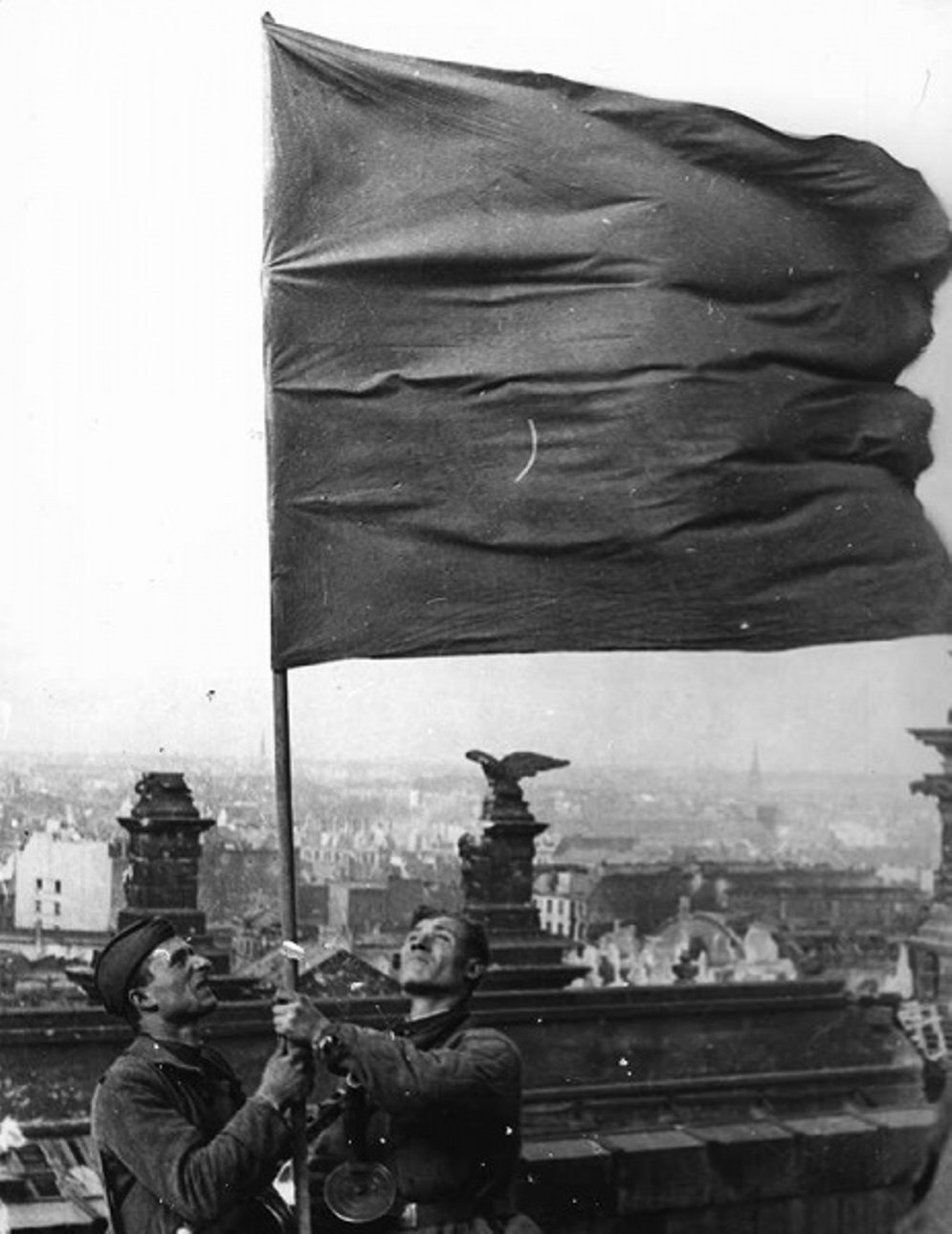
With the departure of the 150th Rifle Division from central Berlin after the battle, the flag was removed from the Reichstag on May 10th to be shipped back to Moscow. The farewell ceremony eventually took place on June 20th 1945 at Berlin’s Tempelhof airfield, as it was shipped east to be carried across Red Square at the Victory Parade four days later.
At the last minute, however, a decision by either Marshal Zhukov or Stalin meant that neither the Victory Banner nor men who were seen as officially responsible for raising it (Kantaria, Egorov, and Berest) appeared in the parade. Speculation is that the men were not suited for marching in formation and that the standard-bearer Neustroev had been so severely wounded in battle he could barely walk.
On May 8th 2011, the Victory Banner hall was opened in the Central Museum of the Armed Forces of the Russian Federation, where an exact copy of the Victory Banner was placed. The real Banner is kept in a special capsule in the Banner Fund, located in the underground room of the museum.
In the capsule made of special glass that blocks ultraviolet radiation, a special environment is maintained with the appropriate temperature, illumination, and humidity of about 60%. The Banner is actually missing a strip 73cm long and 3cm wide, reportedly stolen by female soldiers in the political department of the 150th Rifle Division at the end of the war.
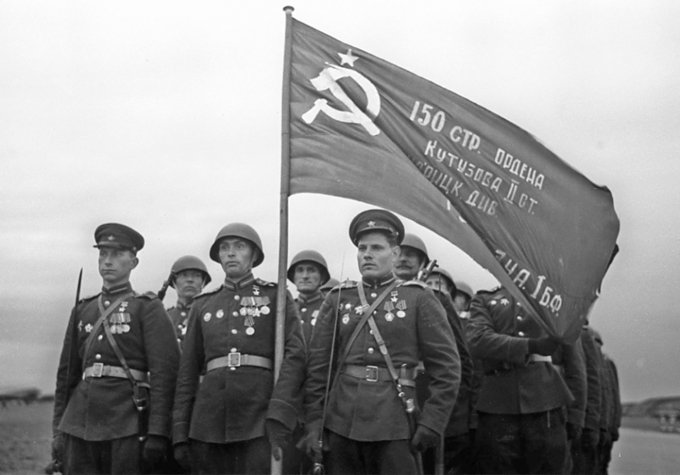
On the question of who exactly raised the first banner on top of the Reichstag, the Institute of Military History of the Ministry of Defense of the Russian Federation responded with the following in 2005: “… each of the armies advancing on Berlin prepared one red banner to be raised over the Reichstag building. On April 22, 1945, the 3rd Shock Army prepared 9 such banners (according to the number of divisions included in it). Red banners, flags and pennants were in all the assault groups that went into battle with the main task of breaking into the Reichstag and raising them on the building. In total, about 40 flags were raised over the Reichstag. In connection with this, and for a number of other reasons, the question of who was the first to accomplish this feat remains debatable to this day.”
It appears that the exact identity of the party responsible for first raising the Soviet flag, or Red Banner, above the Reichstag may – like much else at the time – be lost forever in the fog of war.
Undoubtedly, the most famous image of the flag raising on the Reichstag was that captured by Yevgeny Khaldei on May 2nd.
Well after Bulatov, Qoshqarbaev, the Bondar/Makov/Minin groups had scaled the building – and it is fair to assume, also after the future Heroes of the Soviet Union – Kantaria and Egorov – had done the same.
–
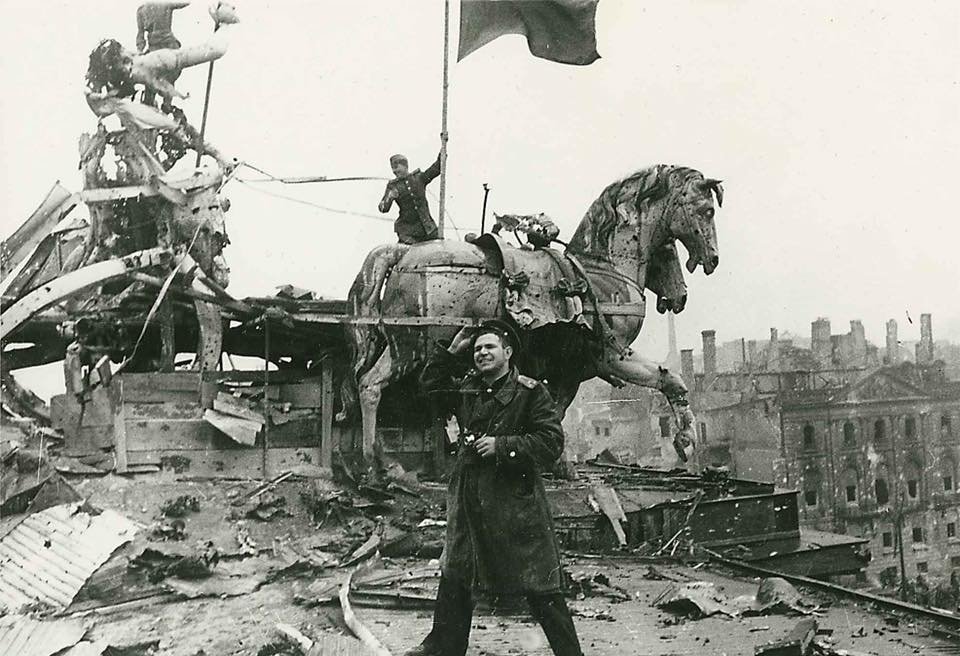
Does Authenticity Matter?
“Qui vincit non est victor nisi victus fatetur”
(He who has conquered is not conqueror
Unless the conquered one confesses it)
Quintus Ennius
Eager to capture a momentous victory shot, the 28-year-old Soviet photographer, Yevgeny Khaldei, arrived in the devastated Nazi capital carrying a special item in his kit – a massive red Soviet flag sewn from tablecloths.
He had commissioned the flag from his uncle in Moscow after seeing Joe Rosenthal’s famous photograph of the U.S. Marines raising the Stars and Stripes at Iwo Jima.
Stalin and Soviet editors wanted their own triumphant image to symbolize victory over Nazi Germany, and Khaldei was determined to deliver it.
On May 2nd 1945, two days after Hitler’s suicide and the initial flag-planting by soldiers, Khaldei made his way to the Reichstag.
He rounded up three willing Red Army infantrymen he found nearby and staged a reenactment of the flag-raising – clambering onto the Reichstag roof with his subjects, handing them the homemade red banner, and orchestrating the composition.
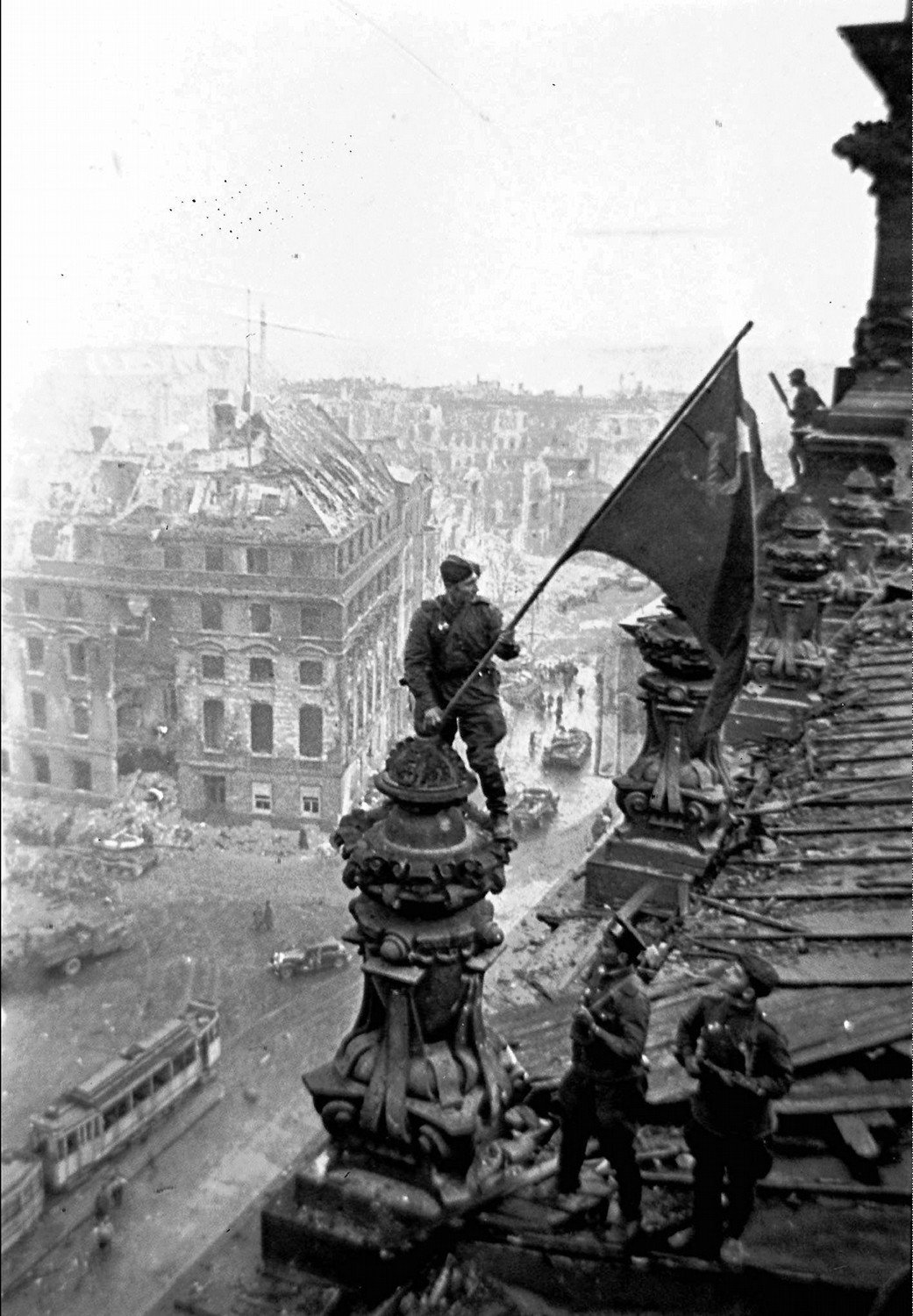
Over the course of a single frenetic session, Khaldei shot an entire roll of film – 36 exposures – from different angles.
One of those frames would become the most iconic Soviet image of World War II, a picture that encapsulated in a single glance the hard-won victory over fascism.
For years afterwards, the identities of the men pictured in the image were disputed.
Often said, in-fact, to be the Kantaria/Egorov/Berest trio.
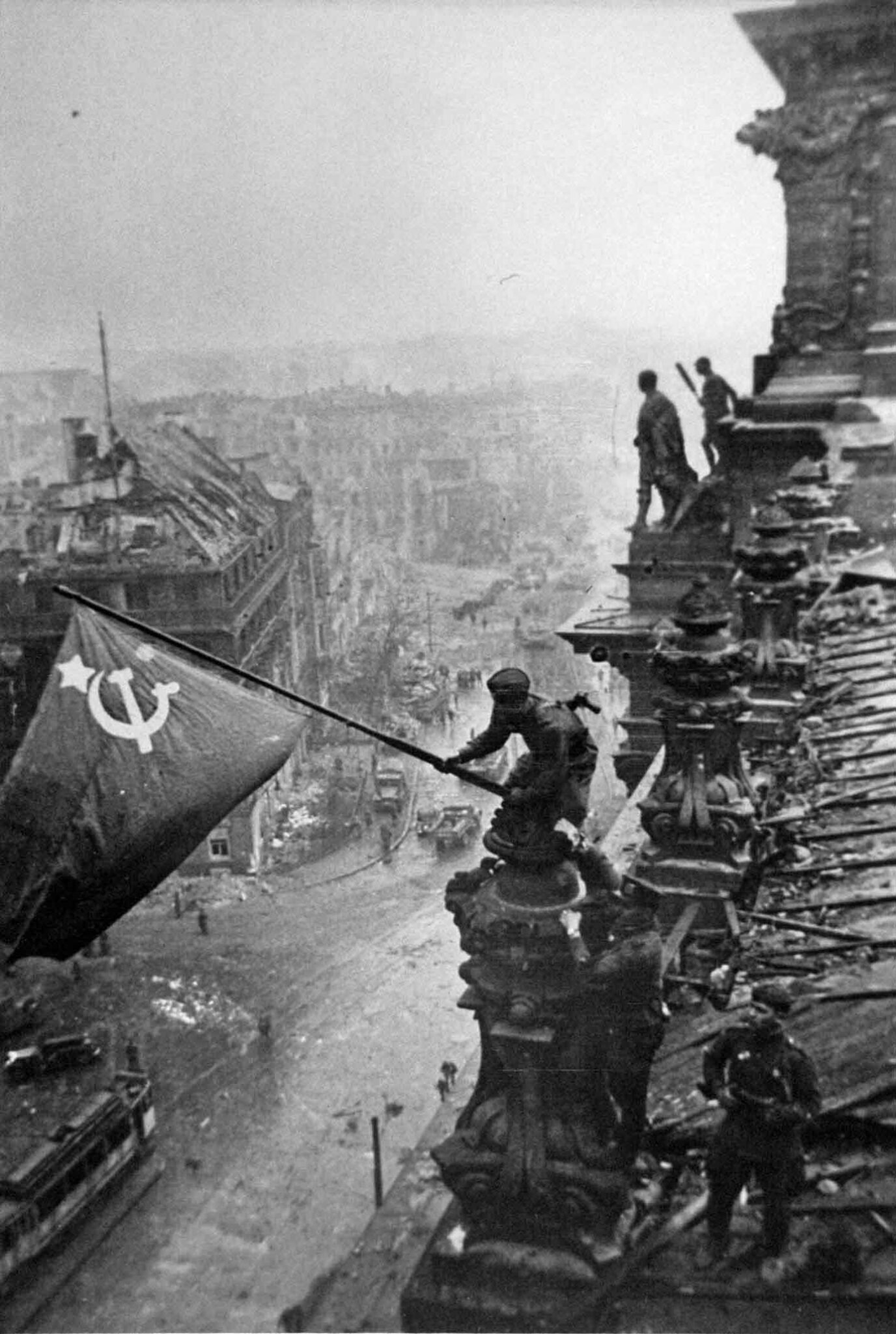
We now know that the soldier attaching the flag was 18-year-old Private Kovalev from Kazakhstan and the two others were Abdulkhakim Ismailov from Dagestan and Leonid Gorychev (also mentioned as Aleksei Goryachev) from Minsk.
Three soldiers chosen in passing by Khaldei who through their ethnicities and backgrounds would be denied the fame this immortal image may have earned them.
Behind the apparent spontaneity of that moment not only lay Khaldei’s careful staging but also some darkroom craft. The photographer never denied that his Reichstag scene was a “photo for history” that he orchestrated to tell a larger truth.
In fact, the image was manipulated before publication to maximize its impact and to scrub away details that Soviet censors found undesirable.
One of Khaldei’s frames showed that one of the flag-raisers – Abdulkhakim Ismailov – seen helping support the banner – had a wristwatch on each arm, obvious proof that he’d been looting amid the chaos in Berlin.
When Khaldei’s editor at TASS saw this, he summoned the photographer and sternly pointed at the incriminating detail.
“A true Soviet soldier does not loot… Fix it, quick,” came the order. Dutifully, Khaldei went back to his darkroom and, using a fine needle, scratched the extra watch off the negative, effectively erasing evidence of Red Army plunder from the final image.
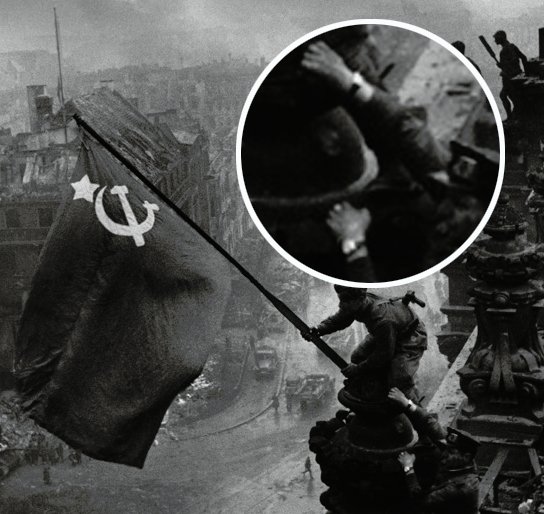
He also heightened the drama of the scene in other ways: darkening the billows of smoke in the sky to add a sense of gravitas and replacing the original flag (which hung limply) with another shot where the banner flowed imposingly in the wind.
The end result was propaganda perfection – an inspirational tableau of Soviet valour with none of the messiness of reality to detract from its message.
To be fair, Khaldei’s Reichstag photo, for all its doctoring, captured something deeply true in the eyes of his countrymen: it symbolised the sacrifice of 27 million Soviet lives and the final triumph over an existential enemy. It instantly entered the pantheon of great war photographs. Like Rosenthal’s Iwo Jima image, Khaldei’s picture was in essence a staged reenactment of a prior event, yet it assumed a life of its own as a historical icon.
Years later, when Western journalists would question Khaldei about the staging and retouching, he remained unapologetic. “It is a good photograph and historically significant. Next question, please,” he quipped curtly. To Khaldei, the greater truth of the moment – the Soviet victory – far outweighed any concern about the photo’s literal candor. In his mind, he hadn’t created a fiction; he had simply ensured that history’s grandeur was properly conveyed on film.
Khaldei operated in a system where photography was both an art form and a weapon of propaganda, and he understood that duality well. “At that time, photography was considered to be the most effective medium of propaganda,” notes one historian of Soviet photojournalism.

It was a tool to inform the people of the Soviet Union – and to shape their world view – by providing stirring images of unity, struggle, and triumph. Khaldei, working under Stalin’s regime, embraced this philosophy. He saw himself not just as a neutral documentarian but as, in his own words, a “propagandist of a just cause”. The cause was the war against Hitler’s Germany, which for Khaldei was deeply personal as well as political. He firmly believed that using his art to bolster morale and memorialize victory was not only acceptable, but imperative.
Khaldei came of age in a Soviet Union where revolutionary art and politics were deeply intertwined. The Russian avant-garde of the 1920s and early 1930s – figures like Alexander Rodchenko in photography and Sergei Eisenstein in cinema – had pioneered bold new visual languages to serve the revolution.
The result of his artistic development was a photographic style that made the Soviet war effort look both epic and human – an aesthetic that continues to captivate viewers. Balancing revolutionary zeal for bold images with the need to tell a story simply.
When the guns fell silent in 1945, Yevgeny Khaldei might have expected to be celebrated as a war hero with a camera. After all, his photographs had bolstered Soviet morale and won international acclaim. But the reality of his post-war life was far more bittersweet. In the late 1940s, the Soviet Union descended into a new wave of political paranoia and anti-Semitism (the so-called “anti-cosmopolitan” purges), and even a decorated Jewish photographer was not immune. Khaldei continued working for TASS for a few years after the war, but his relationship with the agency grew strained. In 1947, his bosses wrote a scathing internal evaluation accusing him of resting on his laurels.
They claimed his “growth as a photojournalist stopped” once the war ended and derided his “exceptionally low” cultural level and lack of political savvy. Khaldei – who had risked his life for his craft – was stung by this rebuke. He later suggested that the real issue wasn’t the quality of his work at all. “The real reason was because I am a Jew,” he said bluntly. In October 1948, TASS fired Khaldei during a round of “staff downsizing,” a euphemism that conveniently masked the purge of many Jewish employees from prominent roles. Thus, at age 31, with victory laurels barely wilted, Khaldei found himself unemployed and out of favor in the country whose triumphs he had helped immortalize.
Only in 1959 did a measure of official acknowledgment return. That year, Khaldei managed to secure a position at Pravda, the Soviet Union’s premier newspaper. For the next decade, he worked there quietly, contributing photos to the state’s daily chronicle. Colleagues recalled him in this period as modest and uncomplaining – a short, stocky man with a warm smile, often seen wearing his old Red Army uniform jacket as a reminder of where he’d been.
In 1970, however, Khaldei was forced to retire from Pravda, effectively ending his press career. He was 53 years old. The official reason for his departure was the standard one given to aging workers, but it coincided with yet another bout of Soviet anti-Semitism (the backlash against Israel’s supporters and the “rootless cosmopolitans” of culture).
Once more, Khaldei’s ethnicity hung like a shadow over his contributions.
He retreated into private life, living on a 80 dollar per-month state pension in a modest one-bedroom apartment on Moscow’s outskirts.
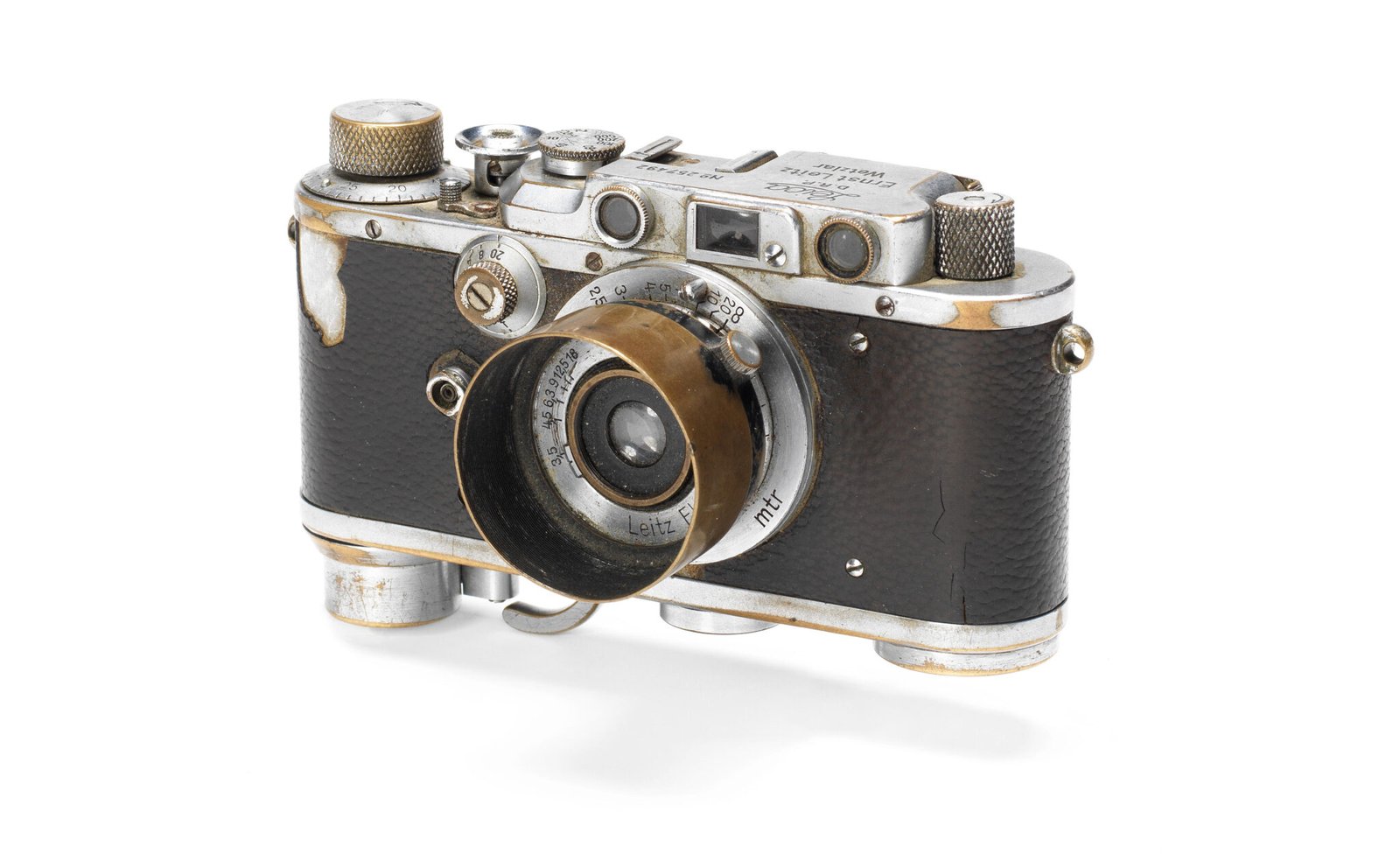
ILegally and culturally, Khaldei’s wartime oeuvre has undergone an interesting transformation in recent years. Because he was employed by TASS (a state agency) when he took those photos, the copyrights to his images belonged to the Soviet state, not to Khaldei personally. Under Russian law, works made by state entities enter the public domain 70 years after creation or publication.
In practical terms, that means Khaldei’s World War II photographs began entering public domain by January 1, 2019, freeing them for use by anyone. This development was confirmed in a 2015 court case involving Khaldei’s daughter, Anna, who had sued a publisher over the unlicensed use of the Reichstag photograph. The court ruled that since TASS was the original rights holder and more than seven decades had passed, the image was no longer under copyright. For Khaldei’s family, this was a bittersweet outcome – it meant they could not claim royalties for the famous works. But for the world, it ensured that his photos can be freely shared and disseminated, further cementing their place in the collective historical memory.
The Leica camera that Khaldei would use to shoot his famous Reichstag photo and many others was eventually sold at auction in 2014 – for a whopping 1.5million dollars.
One final – and fitting – details about Khaldei’s images: not only do they not show the pair celebrated by the Soviet authorities for their flag-raising – Kantaria and Egorov – these photographs also show the distinctive hammer & sickle of the Soviet flag without the insignia of the 150th Rifle Division.
**
Conclusion
The men commonly celebrated as being the first to raise the Soviet flag over the Reichstag – Meliton Kantaria and Mikhail Egorov – were highly likely not the first.
Neither was the Victory Banner of the 150th Rifle Division either present in the famous Yevgeny Khaldei images of the flag raising (featuring other soldiers re-enacting the event on May 2nd 1945 – two days after the first reported flag raising) nor featured in any of the other images taken on top of the building at that time.
Likely the first flag raising on top of the Reichstag was by Grigory Bulatov and Rakhimzhan Qoshqarbaev, although there is no photographic evidence.
Lost in the fog of war – or postwar Soviet manipulation – we may never know the exact truth.
For the Soviets, the spectacle – and finding the right heroes – was decidedly more important.
***
If you’ve enjoyed reading this article, consider booking one of our private guided tours of Berlin.
HISTORICAL ARTICLES
Mythbusting Berlin
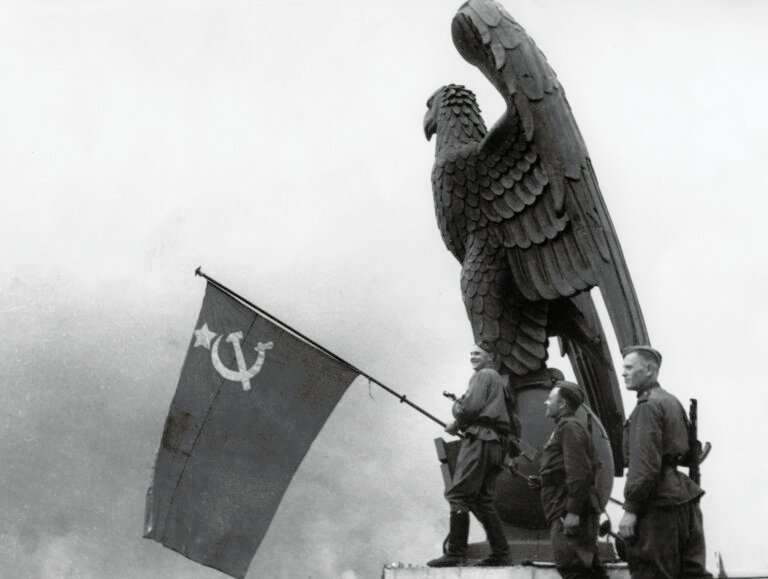
Are There Any Nazi Statues Left In Berlin? – Mythbusting Berlin
Visitors to Berlin often arrive expecting to find the physical remnants of the tyranny of the 20th century still standing – statues of dictators, triumphal arches, or bronze idols. Instead, they often find none. The stone symbols and statues of the Third Reich are still gazing down on them, however, hiding in plain sight. But why are there no statues of Hitler? Did the Allies destroy them all in 1945, or is the truth stranger
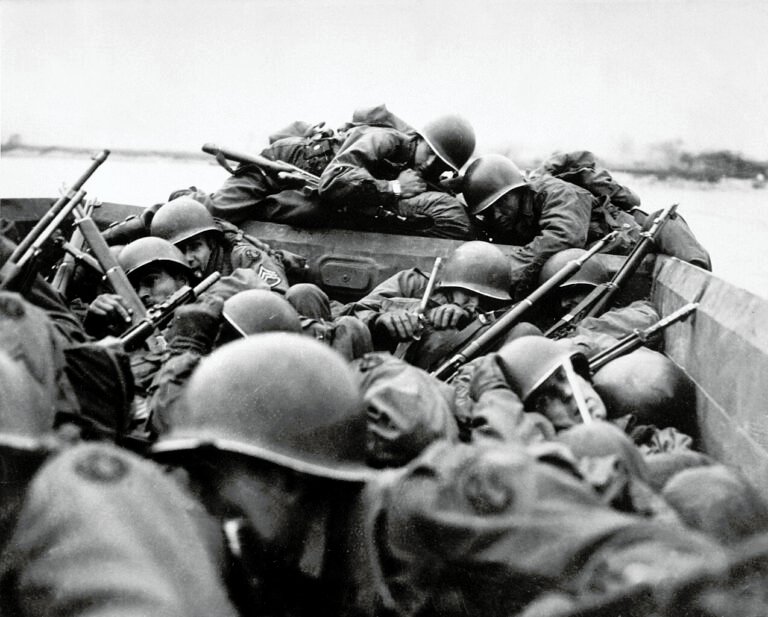
Could The Western Allies Have Captured Berlin? – Mythbusting Berlin
To contemplate a Western Allied capture of Berlin in 1945 is to challenge the established endgame of the Second World War. What was the true military and logistical feasibility of a Western Allied assault on the Nazi capital? What factors truly sealed Berlin’s fate, and what might have changed had the Allies pushed eastward?
Answering these questions means delving into the complex interplay of logistics, political maneuvering, and the competing visions for a post-war world
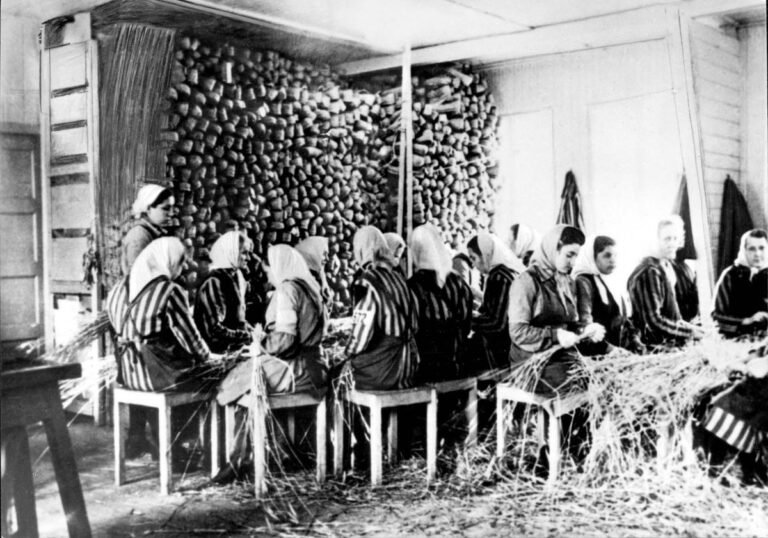
Did Any Of The Rothschild Dynasty Die In The Holocaust? – Mythbusting Berlin
The Rothschild name is synonymous with immense wealth, influence, and persistent conspiracy theories—especially during the era of Nazi Germany. Often targeted by antisemitic propaganda, the family’s survival during World War II has sparked myths about their supposed immunity from Nazi persecution. But did any Rothschild family member actually perish in the Holocaust? This article explores that compelling question, unraveling historical misconceptions and revealing the reality behind one of Europe’s most famous dynasties.
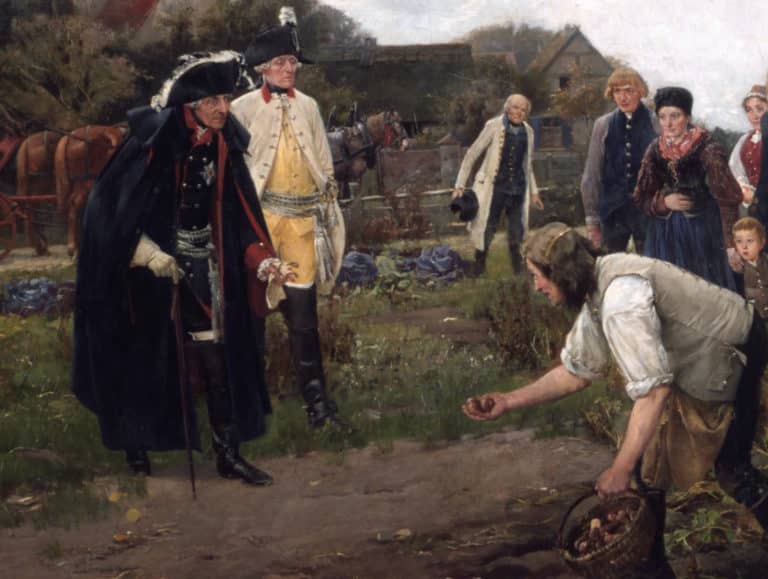
Did Frederick The Great Introduce The Potato To Germany? – Mythbusting Berlin
One of the more bizarre claims to fame attributed to the first King of Prussia is that the man who would go down in history known as Frederick the Great introduced the potato to Germany during his reign back in the 1700s. This starchy root vegetable has undoubtedly become a staple part of German cuisine – an essential addition to any plate of Schnitzel, Schweinshaxn, and Königsberger Klopse – however, whether Frederick the Great is
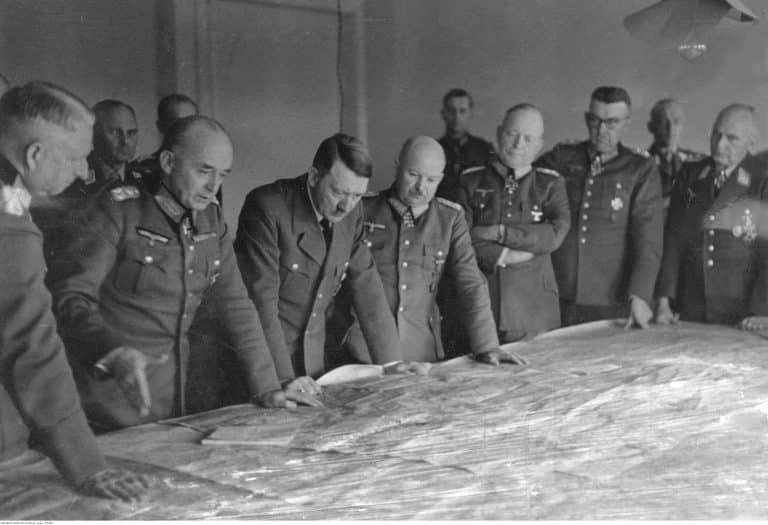
Did Hitler Escape To Argentina In 1945? – Mythbusting Berlin
Although Nazi leader, Adolf Hitler, certainly remains an inescapable figure, could there be any truth to the story of his escape to Argentina in 1945? That the most wanted man on earth could simply vanish, to spend the rest of his life peacefully in South American obscurity captivates imaginations. Yet, despite numerous investigations, this tale persists primarily as myth—fueled by speculation, hearsay, and conspiracy theories.
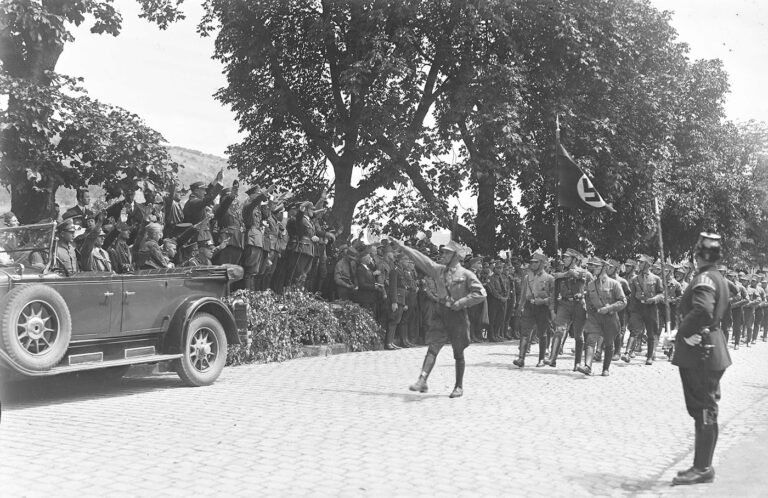
Did Hugo Boss Design The Nazi Uniforms? – Mythbusting Berlin
The idea that Hugo Boss – the man whose name now adorns expensive suits and fragrances – was the creative genius behind the Nazi uniforms suggests a terrifying collision of haute couture and holocaust – a marriage of high style and high crimes. The image is striking: a German tailor sketching the ultimate villain’s costume. But history, as usual, is far messier, more bureaucratic, and more banal than the internet memes suggest. To understand who
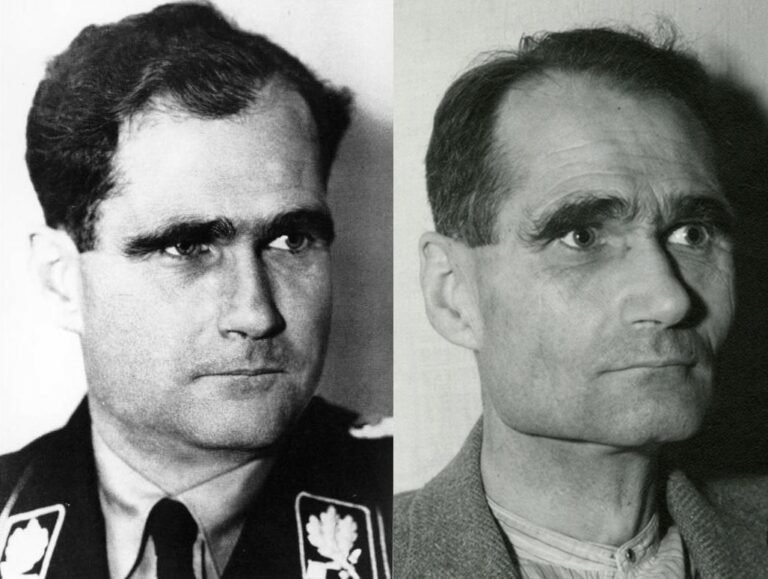
Did Rudolf Hess Really Commit Suicide? – Mythbusting Berlin
On a summer’s day in 1987, the last Nazi war criminal of the Nuremberg trials was found dead in a prison built for hundreds, yet for two decades, housed only him. The official verdict was suicide, a straightforward end to a life defined by fanaticism, delusion, and contradiction.
But the simplicity of the report belied the complexity of the man and the 46 years he had spent in Allied custody. In the meticulously controlled
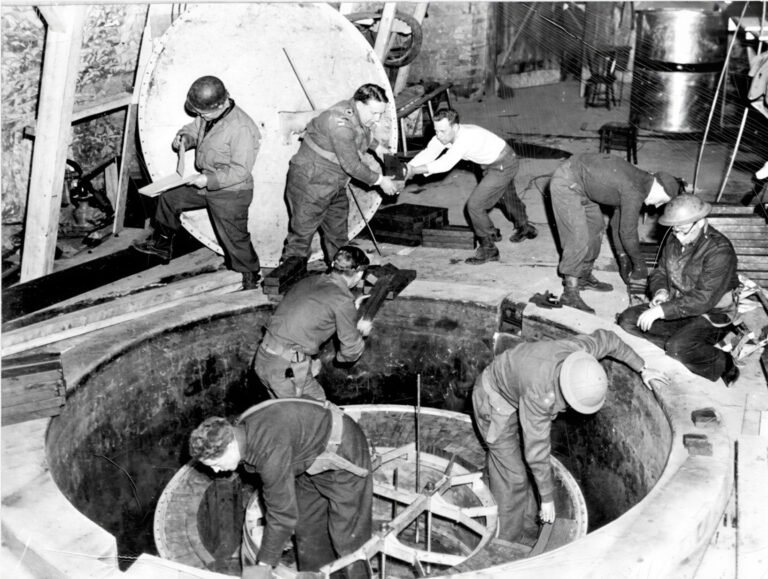
Did The Nazis Develop Nuclear Weapons? – Mythbusting Berlin
The Nazi obsession with super-weapons became so serious in the closing stages of the Second World that Adolf Hitler personally believed that such ‘Wunderwaffen’ both existed in a usable form – and would save the country from defeat. Had the Nazis managed to develop nuclear weapons by 1945 – the outcome of the war would surely have been different. But how close were Hitler, Himmler, and his henchmen to developing an A-bomb?

Did The Nazis Invent Decaf Coffee? – Mythbusting Berlin
Persistent rumors claim that Nazis preferred their coffee anything but pure, leading some to wonder if they might have influenced the development of decaffeinated coffee. Although decaf was already widely available across Europe by the mid-20th century, speculation continues: could the Nazis really have played a role in popularizing—or even discovering—this caffeine-free alternative, or is this simply another caffeinated conspiracy cooked up to sensationalize an ordinary historical detail?

Did The Nazis Invent The Bicycle Reflector? – Mythbusting Berlin
The fruits of wartime ingenuity are plenty – so many, in-fact, that it has become somewhat of a worn cliche that as the guns start firing the innovators get to work, often solving problems while providing more problems for the enemy to overcome.The kind of progress that results in the production of newer improved, more lethal weapons, such as to increase the chances of victory.
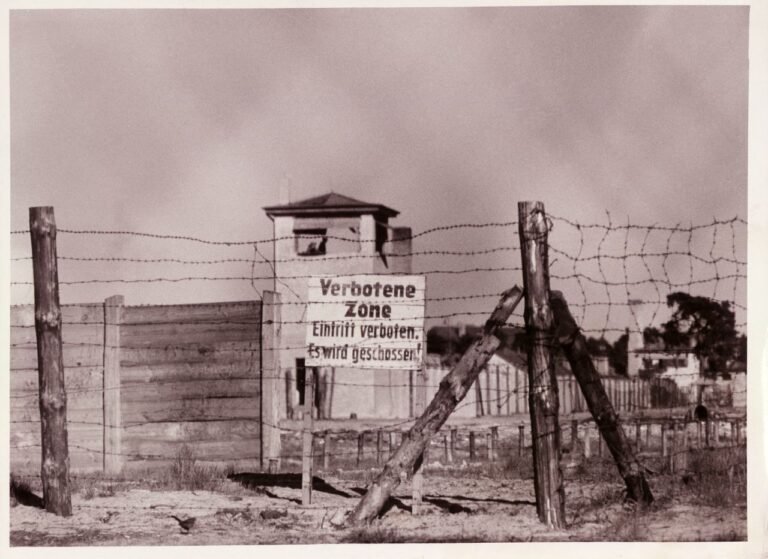
Did The Nazis Run The Largest Counterfeiting Operation In History? – Mythbusting Berlin
During the Second World War the Nazis masterminded an astonishing plot to destabilise Britain by flooding its economy with counterfeit banknotes. Crafted in secret by concentration camp prisoners, this forged fortune became the most ambitious counterfeiting operation ever attempted. But was it history’s largest? Dive into the extraordinary tale of Operation Bernhard,
rife with deception, survival, and intrigue—revealing the truth behind one of the Third Reich’s most audacious schemes and its surprising legacy.
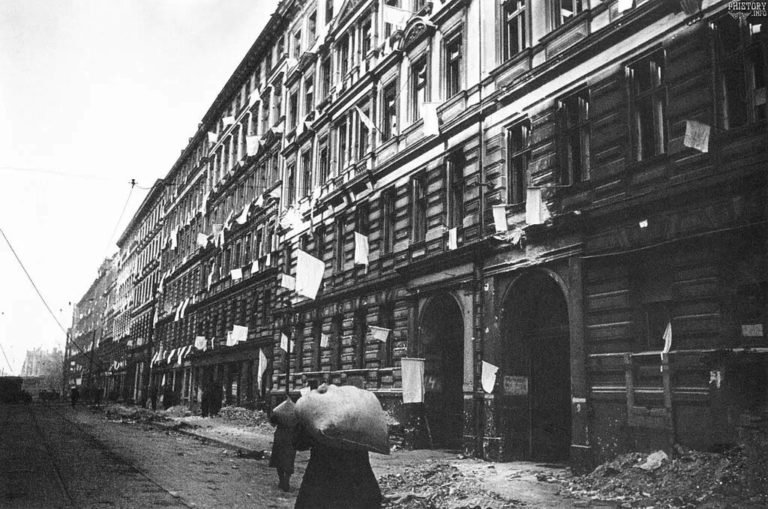
Did The Second World War End In Berlin? – Mythbusting Berlin
When is a war ever truly over? When the last shot is fired in anger would seem like the best measure. Rarely, though, is it possible to gain insight into such a moment.
Remarkably, a record still exists of such a moment at the end of the First World War on the Western Front. A seismic register and recording of the last belching battery of British guns firing artillery across no-man’s-land, followed by a profound
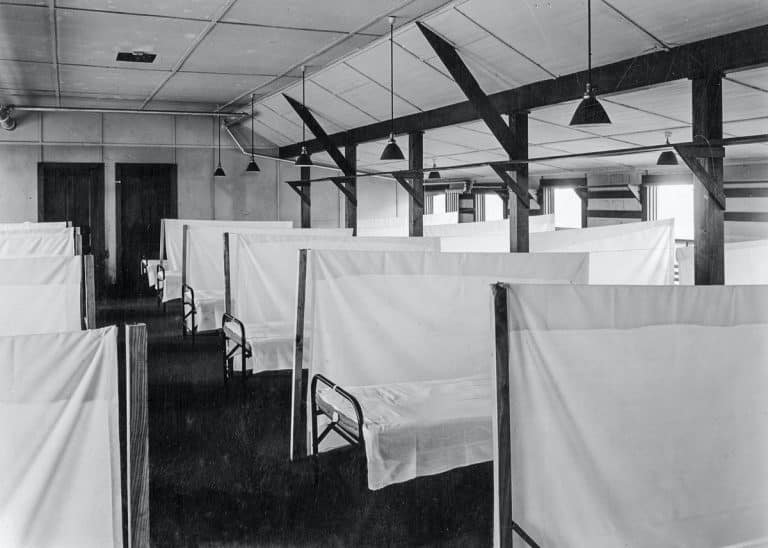
Did The Spanish Flu Pandemic Help The Nazis Take Power? – Mythbusting Berlin
The devastating Spanish Flu pandemic of 1918-1919 struck amid Germany’s post-war turmoil, compounding social instability, economic hardship, and widespread political disillusionment. Could this catastrophic health crisis have indirectly paved the way for Nazi ascension? While often overshadowed by war and revolution, the pandemic’s profound psychological and societal impacts arguably contributed to the perfect storm, enabling extremist ideologies—including Nazism—to gain popularity and ultimately seize power in a fractured Germany.
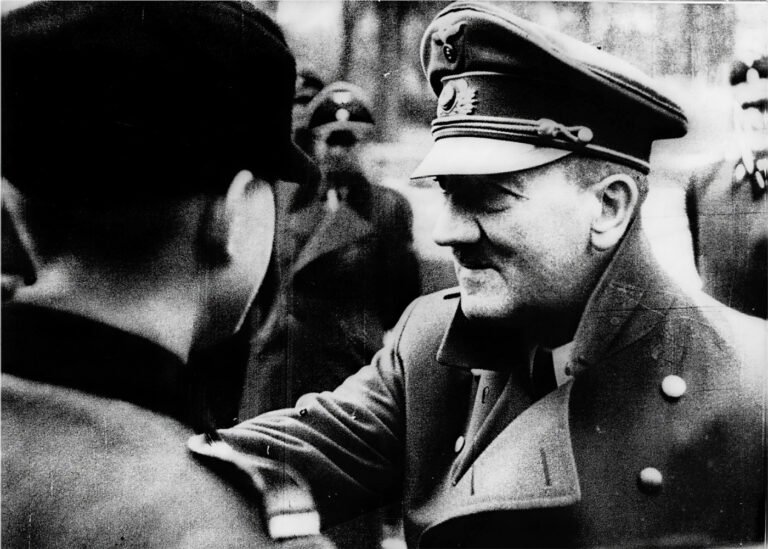
Have Adolf Hitler’s Remains Been DNA Tested? – Mythbusting Berlin
In the smouldering ruins of Berlin in 1945, the world’s most wanted man vanished. Did Adolf Hitler, as official history attests, die by his own hand in the Führerbunker? Or did he escape, fuelling a thousand conspiracy theories that have echoed for decades? For years, the Soviets claimed to hold the gruesome proof of his death: a skull fragment and a set of teeth, locked away in Moscow archives. But in an age of definitive
How Did The Nazi Concentration Camps Differ From The Soviet GULAG?
The Nazi concentration camps and Soviet Gulag system have often been conflated in popular imagination—twin symbols of twentieth-century totalitarian horror. Yet the two systems operated on fundamentally different principles. One extracted labor to fuel industrialisation while accepting mass death as collateral damage; the other evolved into purpose-built machinery of genocide. Understanding these distinctions isn’t merely academic—it reveals how different ideologies produce different atrocities, and why Germany and Russia reckon with these legacies so differently today.
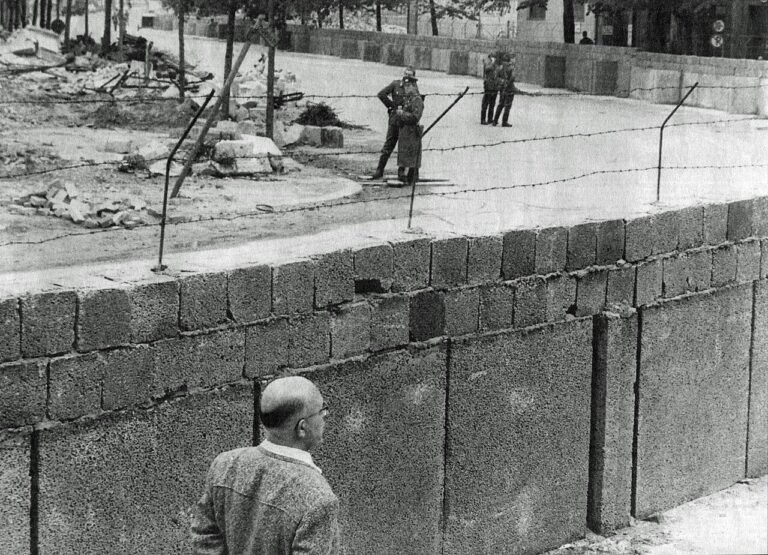
How Long Did It Take To Build The Berlin Wall? – Mythbusting Berlin
It is one of the most enduring images of the 20th century: a city divided overnight. The popular narrative tells us that Berliners went to sleep in a unified city and woke up in a prison. While the shock of August 13th 1961, was very real, the idea that the ‘Wall’ appeared instantly is a historical illusion. The physical scar that bisected Berlin was not a static creation, but a living, malevolent beast that evolved
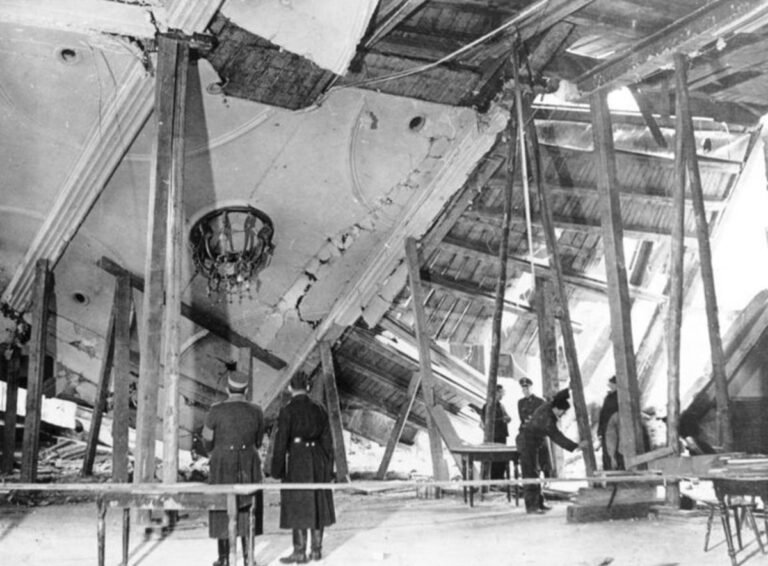
How Many Assassination Attempts On Adolf Hitler Were There? – Mythbusting Berlin
Nazi leader, Adolf Hitler, projected an aura of invincibility, a man of destiny shielded by providence. But behind the carefully constructed image of the untouchable Führer lies a story of constant threat, of bombs that failed to detonate, and errant bullets that missed their mark. Unearth the hidden history of the numerous attempts on Hitler’s life as we explore the courage of those who tried to change the course of history and the devil’s luck
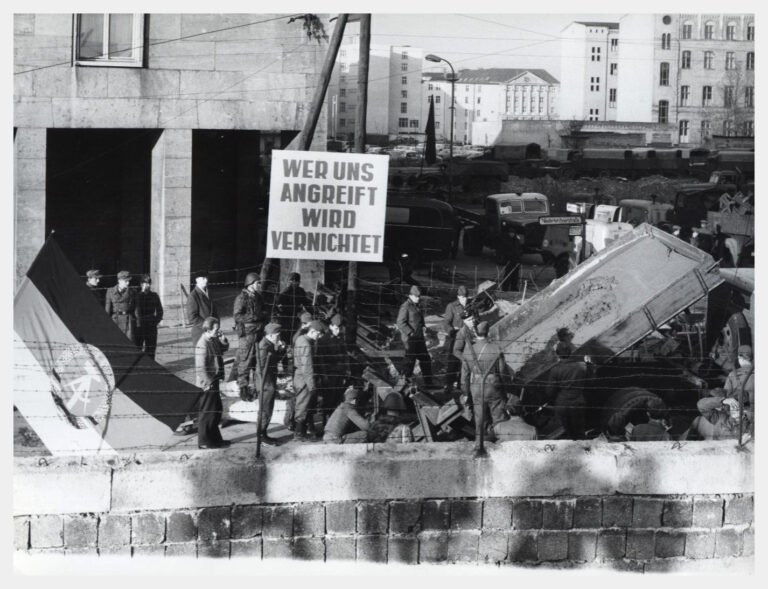
How Many People Died Trying To Escape East Germany? – Mythbusting Berlin
The image of the Berlin Wall is seared into our collective memory, a concrete symbol of Cold War oppression. We think of the daring escapes and the tragic deaths of those who failed. But that well-known number is only a fraction of the truth. The story of those who died trying to escape East Germany is far broader and more complex than most imagine, stretching along a thousand-kilometer border and out into the cold waters
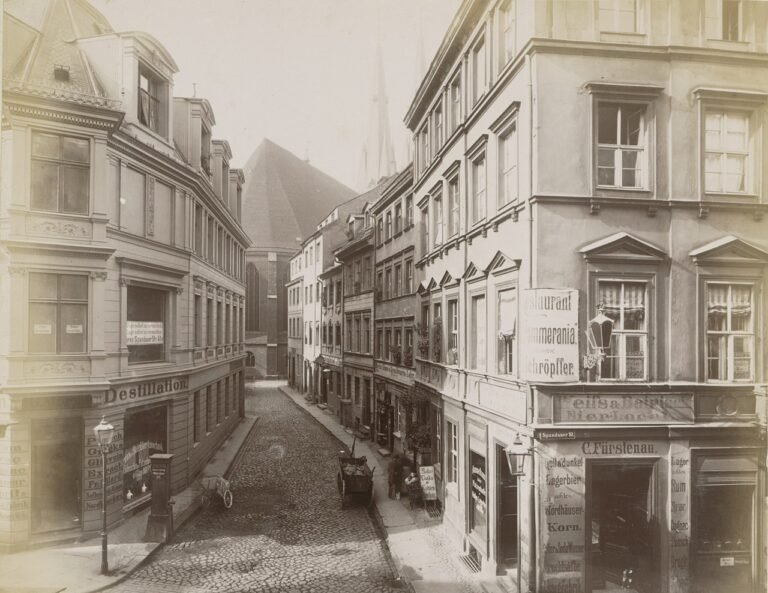
How Old Is Berlin? – Mythbusting Berlin
A relatively new arrival in Europe, Berlin is over 1000 years younger than London, nevermind Rome or Athens, Jerusalem or Jericho. Just how old is Berlin though?
A question fraught with false assumptions and distortions – that has more often than not been answered with propaganda as it has with the cold hard truth.
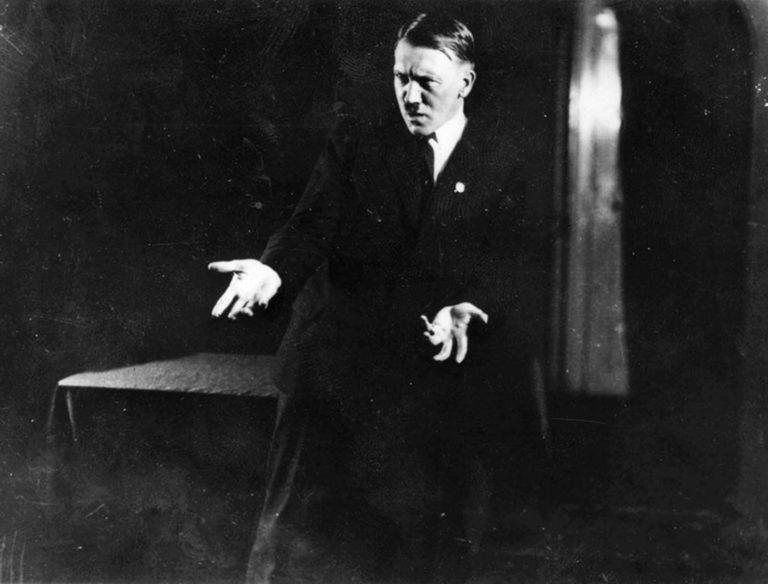
Was Adolf Hitler A Drug Addict? – Mythbusting Berlin
Solving the enigma of the ‘Führer’ has become a preoccupation for many, since the arrival of the Austrian-German onto the world stage – although moving beyond the mythology without falling into the trap of prejudically extrapolating on the psychopathography of Hitler or demonising so as to excuse his actions has proven problematic. What to make of the man who became more than the sum of his masks? The painter; the military dilettante, the mass murderer,

